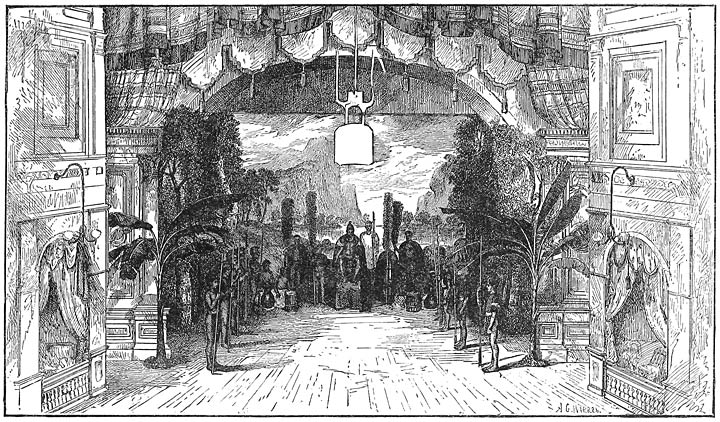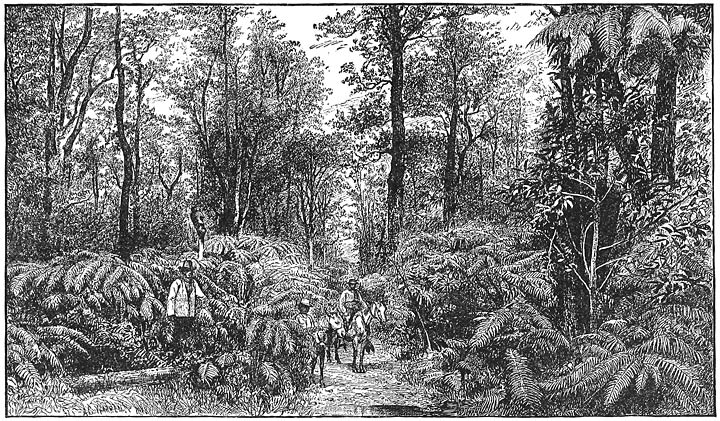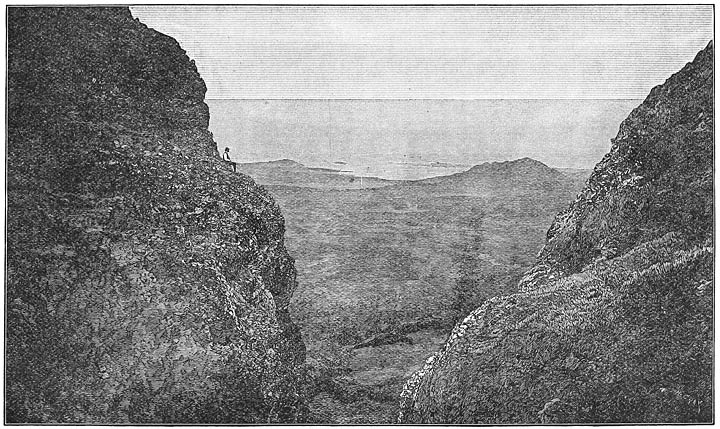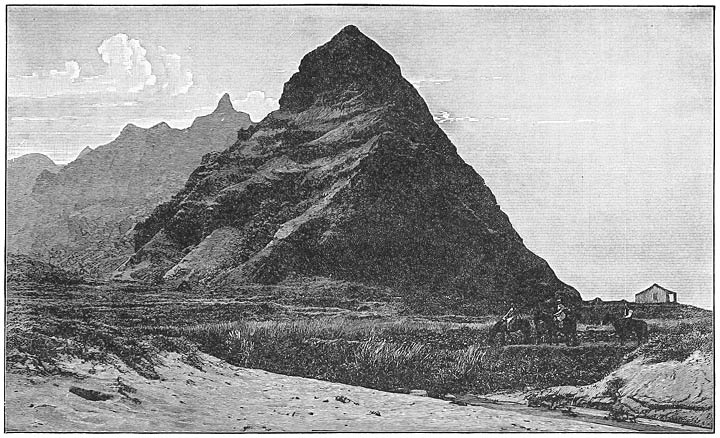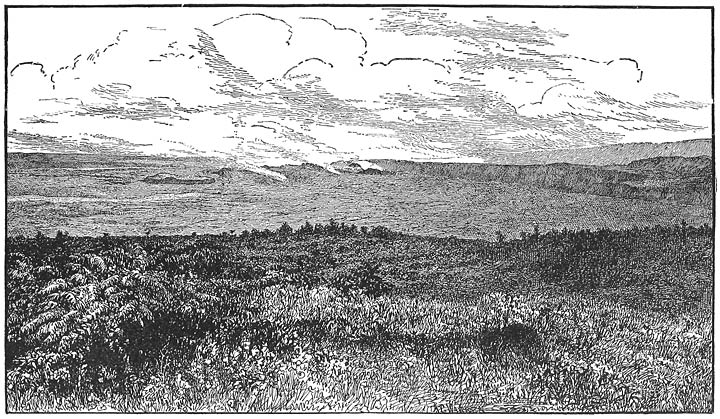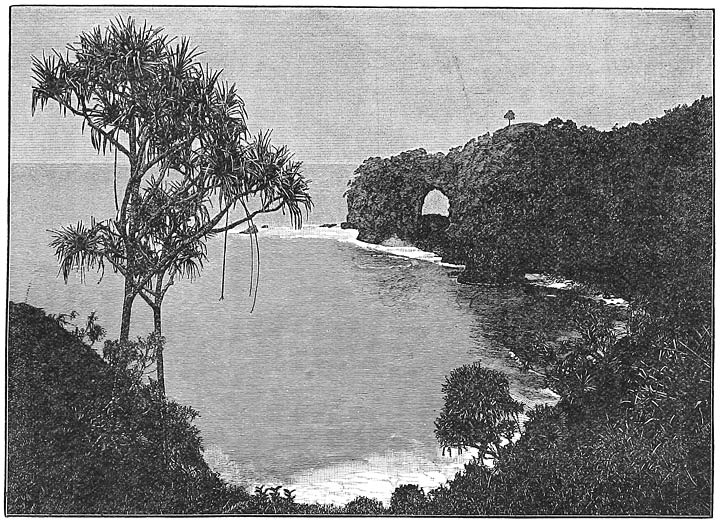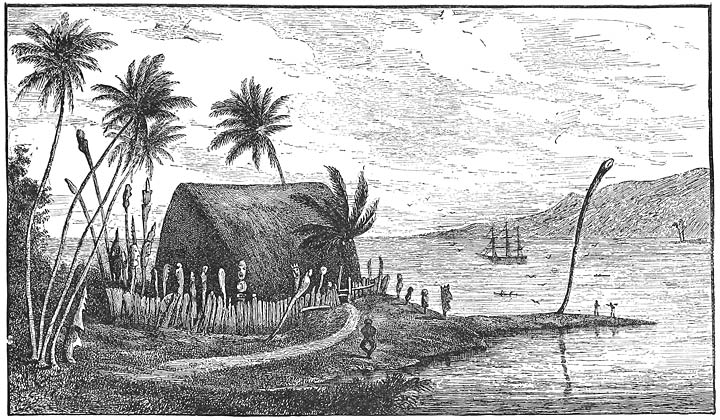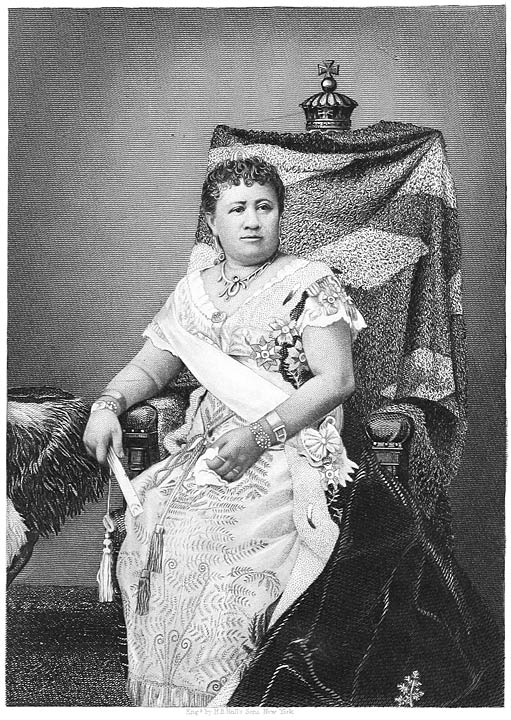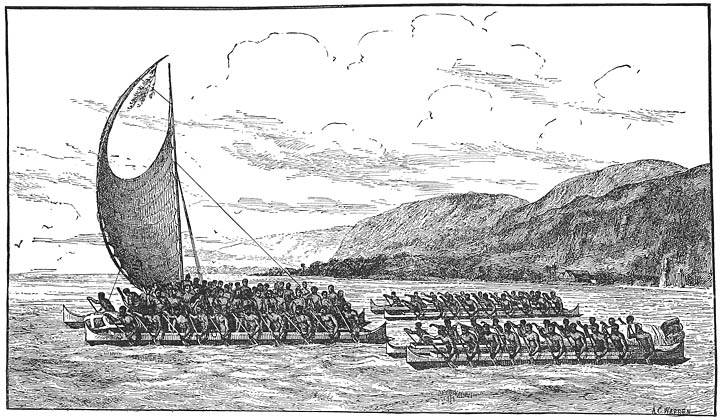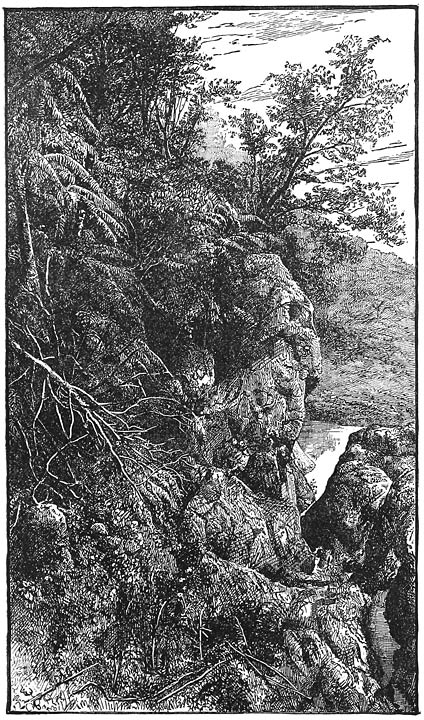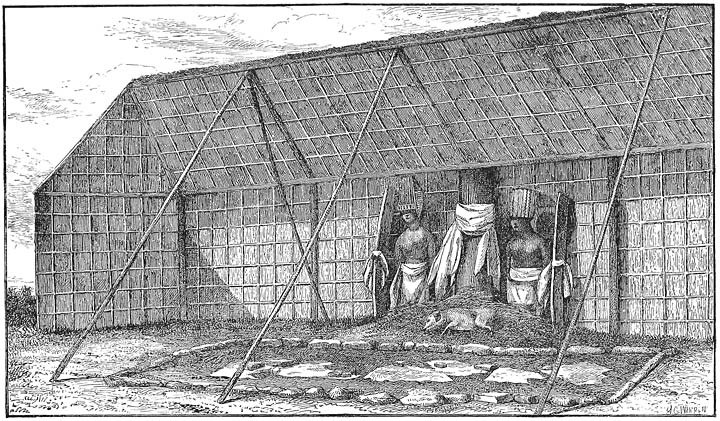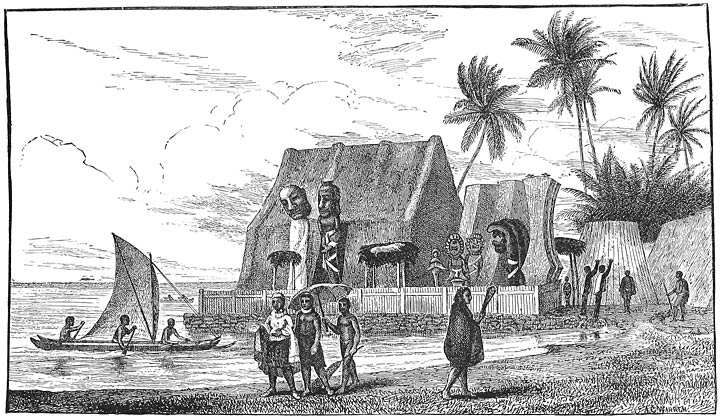

Kalakaua


OF
HAWAII.
OF A
STRANGE PEOPLE.
CHARLES L. WEBSTER & COMPANY.
1888.
Copyright, 1887,
By CHARLES L. WEBSTER & CO.
H. J. HEWITT, PRINTER AND ELECTROTYPER, 37 ROSE ST., N. Y. [5]
PREFACE.
For material in the compilation of many of the legends embraced in this volume obligation is acknowledged to H. R. H. Liliuokalani; General John Owen Dominis; His Excellency Walter M. Gibson; Professor W. D. Alexander; Mrs. E. Beckley, Government Librarian; Mr. W. James Smith, Secretary of the National Board of Education; and especially to Hon. Abram Fornander, the learned author of “An Account of the Polynesian Race, its Origin and Migrations.”
The legends, in the order of their publication, beginning with the first and ending with “The Destruction of the Temples,” may be regarded, so far as they refer to the prominent political events with which they are associated, as in a measure historic. Those following have been selected as the most striking and characteristic of what remains of the fabulous folk-lore of the Hawaiian group. [6]
[7]
CONTENTS.
| PAGE | ||||||||
| Preface. | 5 | |||||||
| Hawaiian Legends: Introduction. | 9–65 | |||||||
| Hina, the Helen of Hawaii. | 67–94 | |||||||
| The Royal Hunchback. | 95–113 | |||||||
| The Triple Marriage of Laa-mai-kahiki. | 115–135 | |||||||
| The Apotheosis of Pele. | 137–154 | |||||||
| Hua, King of Hana. | 155–173 | |||||||
| The Iron Knife. | 175–205 | |||||||
| The Sacred Spear-Point. | 207–225 | |||||||
| Kelea, the Surf-Rider of Maui. | 227–246 | |||||||
| Umi, the Peasant Prince of Hawaii. | 247–315 | |||||||
| Lono and Kaikilani. | 317–331 | |||||||
| The Adventures of Iwikauikaua. | 333–349 | |||||||
| The Prophecies of Keaulumoku. | 351–367 | |||||||
| The Cannibals of Halemanu. | 369–380 | |||||||
| Kaiana, the Last of the Hawaiian Knights. | 381–408 | |||||||
| Kaala, the Flower of Lanai. | 409–427 | |||||||
| The Destruction of the Temples. | 429–446 | |||||||
| The Tomb of Puupehe. | 447–452 | |||||||
| The Story of Laieikawai. | 453–480 | |||||||
| Lohiau, the Lover of a Goddess. | 481–497 | |||||||
| Kahavari, Chief of Puna. | 499–507 | |||||||
| Kahalaopuna, the Princess of Manoa. | 509–522 | |||||||
| Appendix. | 523–530 | |||||||
[11]
The Legends and Myths of Hawaii.
HAWAIIAN LEGENDS: INTRODUCTION.
Physical Characteristics of the Hawaiian Islands—Historic Outlines—The Tabu—Ancient Religion—Ancient Government—Ancient Arts, Habits and Customs—The Hawaii of To-day.
GENERAL RETROSPECT.
The legends following are of a group of sunny islands lying almost midway between Asia and America—a cluster of volcanic craters and coral-reefs, where the mountains are mantled in perpetual green and look down upon valleys of eternal spring; where for two-thirds of the year the trade-winds, sweeping down from the northwest coast of America and softened in their passage southward, dally with the stately cocoas and spreading palms, and mingle their cooling breath with the ever-living fragrance of fruit and blossom. Deeply embosomed in the silent wastes of the broad Pacific, with no habitable land nearer than two thousand miles, these islands greet the eye of the approaching mariner like a shadowy paradise, suddenly lifted from the blue depths by the malicious spirits of the world of waters, either to lure him to his destruction or disappear as he drops his anchor by the enchanted shore.
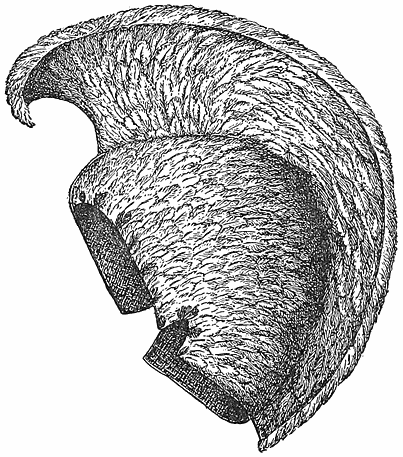
Mahiole, or Feathered War-Helmet.
The legends are of a little archipelago which was unknown to the civilized world until the closing years of the last century, and of a people who for many centuries exchanged no word or product with the rest of mankind; who had lost all knowledge, save the little retained by the dreamiest of legends, of the great world beyond their island home; whose origin may be traced to the ancient Cushites of Arabia, and whose legends repeat the story of the Jewish genesis; who developed and passed through [12]an age of chivalry somewhat more barbarous, perhaps, but scarcely less affluent in deeds of enterprise and valor than that which characterized the contemporaneous races of the continental world; whose chiefs and priests claimed kinship with the gods, and step by step told back their lineage not only to him who rode the floods, but to the sinning pair whose re-entrance to the forfeited joys of Paradise was prevented by the large, white bird of Kane; who fought without shields and went to their death without fear; whose implements of war and industry were of wood, stone and bone, yet who erected great temples to their gods, and constructed barges and canoes which they navigated by the stars; who peopled the elements with spirits, reverenced the priesthood, bowed to the revelations of their prophets, and submitted without complaint to the oppressions of the tabu; who observed the rite of circumcision, built places of refuge after the manner of the ancient Israelites, and held sacred the religious legends of the priests and chronological meles of the chiefs.
As the mind reverts to the past of the Hawaiian group, and dwells for a moment upon the shadowy history of its people, mighty forms rise and disappear—men of the stature of eight or nine feet, crowned with helmets of feathers and bearing spears thirty feet in length. Such men were Kiha, and Liloa, and Umi, and Lono, all kings of Hawaii during the fifteenth and sixteenth centuries; and little less in bulk and none the less in valor was the great Kamehameha, who conquered and consolidated the several islands under one government, and died as late as 1819. And beside Umi, whose life was a romance, stands his humble [14]friend Maukaleoleo, who, with his feet upon the ground, could reach the cocoanuts of standing trees; and back of him in the past is seen Kana, the son of Hina, whose height was measured by paces.
GROUP OF ANCIENT WEAPONS.

War-Club.

Pahoa, or Wooden Dagger.

Shark’s-Teeth Knife.

Flint-edged Knife.

Stone Battle-Axe.

Stone Battle-Axe.
Ihe, or Javelin, 6 to 8 feet long.
Spear, 16 to 20 feet long.
And, glancing still farther backward through the centuries, we behold adventurous chiefs, in barges and double canoes a hundred feet in length, making the journey between the Hawaiian and more southern groups, guided only by the sun and stars. Later we see battles, with dusky thousands in line. The warriors are naked to the loins, and are armed with spears, slings, clubs, battle-axes, javelins and knives of wood or ivory. They have neither bows nor shields. They either catch with their hands or ward with their own the weapons that are thrown. Their chiefs, towering above them in stature, have thrown off their gaudy feather cloaks and helmets, and, with spear and stone halberd, are at the front of battle. The opposing forces are so disposed as to present a right and left wing and centre, the king or principal chief commanding the latter in person. In the rear of each hostile line are a large number of women with calabashes of food and water with which to refresh their battling fathers, husbands and brothers. While the battle rages their wails, cries and prayers are incessant, and when defeat menaces their friends they here and there take part in the combat. The augurs have been consulted, sacrifices and promises to the gods have been made, and, as the warring lines approach, the war-gods of the opposing chiefs, newly decorated and attended by long-haired priests, are borne to the front. War-cries and shouts of defiance follow. The priests retire, and the slingers open the battle. Spears are thrown, and soon the struggle is hand-to-hand all over the field. They fight in groups and squads around their chiefs and leaders, who range the field in search of enemies worthy of their weapons. No quarter is given or expected. The first prisoners taken are reserved as offerings to the gods, and are regarded as the most precious of sacrifices. Finally the leading chief of one of the opposing armies falls. A desperate struggle over his body ensues, and his dispirited followers begin to give ground and are soon in retreat. Some escape to a stronghold in the neighboring mountains, and a few, perhaps, to a temple of refuge; but the most of them are overtaken and slain. The prisoners who are spared become the [15]slaves of their captors, and the victory is celebrated with feasting and bountiful sacrifices to the gods.
This is a representative battle of the past, either for the supremacy of rival chiefs or in repelling invasion from a neighboring island. But here and there we catch glimpses of actual conflicts indicative of the warlike spirit and chivalry of the early Hawaiians. Far back in the past we see the beautiful Hina abducted from her Hawaiian husband by a prince of Molokai, and kept a prisoner in the fortress of Haupu until her sons grow to manhood, when she is rescued at the end of an assault which leaves the last of her defenders dead. Later we see the eight hundred helmeted chiefs of the king of Hawaii, all of noble blood, hurling themselves to destruction against the spears of the armies of Maui on the plains of Wailuku. And then, less than a generation after, Kamehameha is seen in the last battle of the conquest, when, at the head of sixteen thousand warriors, he sweeps the Oahuan army over the precipice of Nuuanu and becomes the master of the archipelago. Finally we behold Kekuaokalani, the last defender in arms of the Hawaiian gods and temples, trampling upon the edict of the king against the worship of his fathers, and dying, with his faithful wife Manono, on the field of Kuamoo.
In the midst of these scenes of blood the eye rests with relief upon numerous episodes of love, friendship and self-sacrifice touching with a softening color the ruddy canvas of the past. We see Kanipahu, the exiled king of Hawaii, delving like a common laborer on a neighboring island, and refusing to accept anew the sceptre in his old age because his back had become crooked with toil and he could no longer look over the heads of his subjects as became a Hawaiian king. We see Umi, a rustic youth of royal mien and mighty proportions, boldly leap the palace-walls of the great Liloa, push aside the spears of the guards, enter the royal mansion, seat himself in the lap of the king, and through the exhibition of a forgotten token of love receive instant recognition as his son. And now Lono, the royal great-grandson of Umi, rises before us, and we see him lured from self-exile by the voice of his queen, reaching him in secret from without the walls of the sovereign court of Oahu, to return to Hawaii and triumph over his enemies. These and many other romantic incidents present themselves in connection with the [16]early Hawaiian kings and princes, and are offered in the succeeding pages with every detail of interest afforded by available tradition.
PHYSICAL CHARACTERISTICS.
A few general remarks concerning the physical characteristics of the Hawaiian Islands would seem to be appropriate in presenting a collection of legends dealing alike with the history and folk-lore of their people. The islands occupy a place in a great waste of the Pacific between the nineteenth and twenty-third degrees of north latitude, and the one hundred and fifty-fourth and one hundred and sixty-first degrees of longitude west from Greenwich. They are two thousand one hundred miles southwest from San Francisco, and about the same distance from Tahiti.
The group consists of ten islands, including two that are little more than barren rocks. The farthest are about three hundred miles from each other, measuring from their extreme boundaries, and their aggregate area is a little more than six thousand one hundred square miles. Of the eight principal islands all are habitable, although the small islands of Niihau and Kahoolawe are used almost exclusively as cattle-ranges.
The most of the shores of the several islands are fringed with coral, but their origin seems to be indisputably shown in the numerous craters of extinct volcanoes scattered throughout the group, and in the mighty fires still blazing from the mountain-heights of Hawaii.
By far the larger part of the area of the islands is mountainous; but from the interior elevations, some of them reaching altitudes of from ten to fourteen thousand feet, flow many small streams of sweet water, widening into fertile valleys as they reach the coast, while here and there between them alluvial plateaus have been left by the upland wash.
With rare exceptions the mountain-sides are covered with vegetation, some of sturdy growth, capable of being wrought into building materials and canoes, while lower down the ohia, the palm, the banana, and the bread-fruit stand clothed in perpetual green, with groves of stately cocoas between them and the sea.
Once the fragrant sandal-wood was abundant in the mountains, but it became an article of commerce with the natives in [17]their early intercourse with the white races, and is now rarely seen. Once the valleys and plateaus were covered with growing taro and potatoes; now the cane and rice of the foreigner have usurped the places of both, and in the few shaded spots that have been left him the forgiving and revengeless Hawaiian sadly chants his wild songs of the past.
Neither within the memory of men nor the reach of their legends, which extend back more than a thousand years, has there been an active volcano in the group beyond the large island of Hawaii, which embraces two-thirds of the solid area of the archipelago. The mighty crater of Haleakala, more than thirty miles in circumference, on the island of Maui, has slept in peace among the clouds for ages, and hundreds of lesser and lower craters, many of them covered with vegetation, are found scattered among the mountains and foot-hills of the group; but their fires have long been extinct, and the scoria and ashes buried at their bases tell the story of their activity far back in the past.
It must have been a sight too grand for human eyes to witness when all these dead volcanic peaks, aglow with sulphurous flames, lit up the moonless midnights of the eight Hawaiian seas with their combined bombardment of the heavens!
On the island of Hawaii alone have the fires of nature remained unextinguished. At intervals during the past thousand years or more have Mauna Kea, Mauna Hualalai and Mauna Loa sent their devastating streams of lava to the sea, and to-day the awful, restless and ever-burning caldron of Kilauea, nearly a mile in circumference, is the grandest conflagration that lights up the earth. Within its lurid depths, in fiery grottoes and chambers of burning crystal, dwell Pele and her companions, and offerings are still thrown to them by superstitious natives. Do they yet believe in these deities after more than sixty years of Christian teaching? after their temples have been leveled and their gods have been destroyed? after their tabus have been broken and their priesthood has been dethroned and dishonored? The only answer is, “The offerings are still made.”
Although the channel and ocean coasts of the islands are generally bold, rocky and precipitous, there are numerous bays and indentations partially sheltered by reefs and headlands, and many stretches of smooth and yellow beach, where the waves, touched by the kona, or the trade-wind’s breath, chase each other [18]high up among the cocoa’s roots and branches of the humble hau-tree clinging to the sands. The harbor of Honolulu, on the island of Oahu, is the only one, however, where passengers and freights of ocean crafts may be received or landed without the aid of lighters.
The most of the useful and ornamental growths of the tropics now flourish on the islands. The indigenous plants, however, are confined to the banana, plantain, cocoanut, breadfruit, ohia, sugar-cane, arrow-root, yam, sweet potato, taro, strawberry, raspberry and ohelo. The lime, orange, mango, tamarind, papaia, guava, and every other edible product, aside from those named as indigenous, are importations of the past century.
The only domestic animals of the ancient Hawaiians were dogs, swine and fowls, and the most formidable four-legged creatures found in their fields and forests were mice and lizards. Wild geese, including a species peculiar to the islands, ducks, snipe and plover were abundant in their seasons, but seem to have been sparely eaten; and owls, bats, and a few varieties of birds of simple song and not over-brilliant plumage made up about the sum total of animal life on the islands a hundred years ago. But the native could well afford to be content with this limited provision, since it did not include snakes, mosquitoes, centipedes, tarantulas, or scorpions.
To what processes of creation or isolation do the Hawaiian Islands owe their existence? Were they raised from the depths of the ocean by volcanic action, as plainly suggested by their formation? or are they a part of a great sunken continent which speculation, sustained by misty tradition, claims once occupied the Polynesian seas? Hawaiian meles mention islands no longer to be found, and the facility with which communication was maintained between the Hawaiian and more southern groups previous to the twelfth century renders plausible the assumption that this intercourse was abruptly terminated six or seven centuries ago by the disappearance of a number of intervening atolls or islands which had served as guides to early Polynesian navigators. The gigantic ruins of temples and other structures found on Easter and one or two other islands of the equatorial Pacific are almost unanswerable arguments in favor of the theory of a sunken Polynesian continent; but the question will probably never be removed beyond the field of surmise. [19]
HISTORIC OUTLINES.
The source and early history of the Hawaiian people, and, in fact, of the Polynesian race, of which they are a part, are involved in doubt. They have generally been regarded as an offshoot of the great Malayan family; but more recent as well as more thorough investigation, particularly by Judge Fornander, the learned and conscientious historian, with reasonable conclusiveness shows the Polynesian and Malayan races to be of distinct and widely different origin.
Accepting this conclusion, we trace the strictly Polynesian tribes to an Aryan beginning, somewhere in Asia Minor or Arabia. There, in the remote past, it is assumed, they were brought in close contact with early Cushite and Chaldeo-Arabian civilizations. Subsequently drifting into India, they to some extent amalgamated with the Dravidian races, and, following the channels of the great Chaldean commerce of that period, at length found a home in the Asiatic archipelago from Sumatra to Luzon and Timor.
The exact time of their settlement on the large coast islands of southern Asia cannot be definitely determined, but their legends and genealogies leave little room to doubt that it was contemporaneous with the Malay and Hindoo invasions of Sumatra, Java, and other islands of the archipelago, during the first and second centuries of the Christian era, that the Polynesians were pushed out—not at once in a body, but by families and communities covering a period of years—to the smaller and more remote islands of the Pacific.
Their first general rendezvous was in the Fiji group, where they left their impress upon the native Papuans. Expelled from, or voluntarily leaving, the Fijis, after a sojourn there of several generations, the Polynesians scattered over the Pacific, occupying by stages the several groups of islands where they are now found. Moving by the way of the Samoan and Society Islands, the migratory wave did not reach the Hawaiian group until about the middle of the sixth century.
Nanaula, a distinguished chief, was the first to arrive from the southern islands. It is not known whether he discovered the group by being blown northward by adverse winds, or in deliberately adventuring far out upon the ocean in search of new [20]lands. In either event, he brought with him his gods, priests, prophets and astrologers, and a considerable body of followers and retainers. He was also provided with dogs, swine and fowls, and the seeds and germs of useful plants for propagation. It is probable that he found the group without human inhabitants.
During that period—probably during the life of Nanaula—other chiefs of less importance arrived with their families and followers either from Tahiti or Samoa. They came in barges and large double canoes capable of accommodating from fifty to one hundred persons each. They brought with them not only their priests and gods, but the earliest of Polynesian traditions. It is thought that none of the pioneers of the time of Nanaula ever returned to the southern islands, nor did others immediately follow the first migratory wave that peopled the Hawaiian group.
For thirteen or fourteen generations the first occupants of the Hawaiian Islands lived sequestered from the rest of the world, multiplying and spreading throughout the group. They erected temples to their gods, maintained their ancient religion, and yielded obedience to their chiefs. The traditions of the period are so meagre as to leave the impression that it was one of uninterrupted peace, little having been preserved beyond the genealogies of the governing chiefs.
But late in the tenth or early in the beginning of the eleventh century the Hawaiians were aroused from their dream of more than four centuries by the arrival of a party of adventurers from the southern islands, probably from the Society group. It was under the leadership of Nanamaoa. He was a warlike chief, and succeeded in establishing his family in power on Hawaii, Maui and Oahu. But stronger leaders were soon to follow from the south. Among the first was the high-priest Paao, from Samoa. He arrived during the reign of Kapawa, the grandson of Nanamaoa, or immediately after his death. The people were in an unsettled condition politically, and Paao, grasping the situation, either sent or returned in person to Samoa for Pili, a distinguished chief of that island. Arriving with a large following, Pili assumed the sovereignty of the island of Hawaii and founded a new dynasty. Paao became his high-priest, and somewhat disturbed the religious practices of the people by the introduction [21]of new rites and two or three new gods. However, his religion did not seem to differ greatly from that of the native priests, and from him the last of the priesthood, seven hundred years after, claimed lineage and right of place.
The intercourse thus established between the Hawaiian and southern groups by Nanamaoa, Paao and Pili continued for about one hundred and fifty years, or until the middle or close of the twelfth century. During that period several other warlike families from the south established themselves in the partial or complete sovereignty of Oahu, Maui and Kauai, and expeditions were frequent between the group and other distant islands of Polynesia. It was a season of unusual activity, and the legends of the time are filled with stories of love, conquest and perilous voyages to and from the southern islands.
In that age, when distant voyages were frequent, the Polynesians were bold and intelligent navigators. In addition to large double canoes capable of withstanding the severest weather, they possessed capacious barges, with planks corded and calked upon strong frames. They were decked over and carried ample sail. Their navigators had some knowledge of the stars; knew the prominent planets and gave them names; were acquainted with the limits of the ecliptic and situation of the equator. With these helps, and keenly watchful of the winds and currents, of ocean drifts and flights of birds, they seldom failed to reach their destination, however distant.
Near the close of the twelfth century all communication between the Hawaiian and southern groups suddenly ceased. Tradition offers no explanation of the cause, and conjecture can find no better reason for it than the possible disappearance at that time of a number of island landmarks which had theretofore served as guides to the mariner. The beginning of this period of isolation found the entire group, with the exception, perhaps, of Molokai and a portion of Oahu, in the possession of the southern chiefs or their descendants.
It has been observed that the first discovery and occupation of the islands by Polynesians from the Society and Samoan groups occurred in the sixth century, and that more than four hundred years later a second migratory tide from the same and possibly other southern islands reached the coasts of Hawaii, continuing for more than a century and a half, and completely [22]changing the political, and to some extent the social, condition of the people. Although nearly five centuries elapsed between the first and second migratory influxes from the south, during which the inhabitants of the group held no communication with the rest of the world, it is a curious fact that the Pili, Paumakua, and other chiefly families of the second influx traced back their lineage to the ancestors of the chiefs of the first migration, and made good their claim to the relationship by the recital of legends and genealogies common to both.
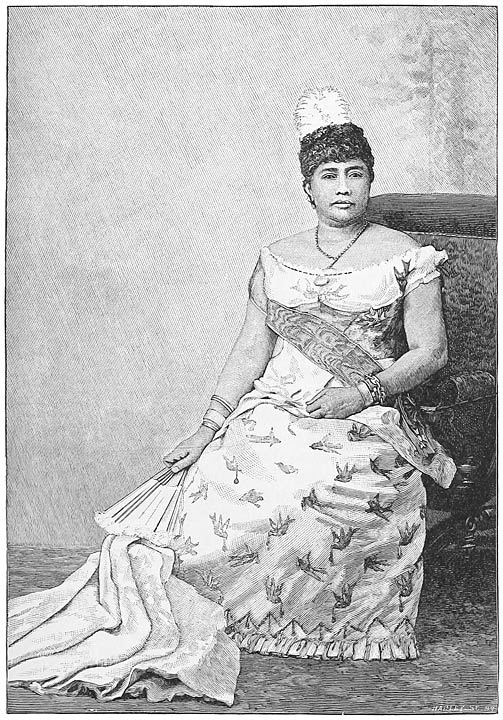
Princess Liliuokalani.
At the close of the second migratory period, which concluded their intercourse with the world beyond them for more than six hundred years, or from A.D. 1175 to 1778, the people of the group had very generally transferred their allegiance to the newly-arrived chiefs. The notable exceptions were the Maweke and Kamauaua families of Oahu and Molokai, both of the ancient Nanaula line. Although they were gradually crowded from their possessions by their more energetic invaders, the high descent of the prominent native chiefs was recognized, and by intermarriage their blood was allowed to mingle with the royal currents which have flowed down the centuries since they ceased to rule.
A mere outline of the political history of the islands from the twelfth century to the nineteenth is all that will be given here. The legends following will supply much that will be omitted to avoid repetition.
Until the final conquest of the group by Kamehameha I. at the close of the last century, the five principal islands of the archipelago—Hawaii, Maui, Oahu, Kauai and Molokai—were each governed, as a rule, by one or more independent chiefs. The smaller islands of Lanai and Kahoolawe were usually subject to Maui, while Niihau always shared the political fate of Kauai.
On each island, however, were descendants of distinguished ancient chiefs and heroes, who were recognized as of superior or royal blood, and with them originated the supreme chiefs, kings, or mois of the several islands, whose lines continued in authority, with interruptions of insurrection and royal feuds, until the consolidation of the group by Kamehameha. No one was recognized as a tabu chief unless his genealogical record showed him to be of noble blood, and intermarriage between the ruling families, [23]as well as between the lesser chiefs of the several islands, in time united the entire aristocracy of the group by ties of blood, and gave to all of royal strain a common and distinguished ancestry. The nobility and hereditary priesthood claimed to be of a stock different from that of the common people, and their superior stature and intelligence seemed to favor the assumption. To keep pure the blood of the chiefly classes, far back in the past a college of heraldry was established, before which all chiefs were required to recite their genealogies and make good their claims to noble descent.
The legends of the group abound in stories of romantic and sanguinary internal conflicts, and political and predatory wars between the islands; but down to the time of Kamehameha but a single attempt had been made to subjugate the entire archipelago. This bold scheme was entertained by a king of the island of Hawaii who reigned during the latter part of the thirteenth century. He succeeded in overrunning Maui, Oahu and Molokai, but was defeated and taken prisoner on Kauai.
Without further reference to the intervening years from the twelfth century to the eighteenth—a long period of wars, festivals, tournaments, and royal and priestly pageantry—we will now glance at the condition of the islands at the time of their discovery by Captain Cook, a little more than a century ago. It was estimated that the islands then contained a population of four hundred thousand souls. This estimate has been considered large. But when it is noted that fifteen years later there were between thirty and forty thousand warriors under arms in the group at the same time, with large reserves ready for service, the conclusion is irresistible that the population could scarcely have been less. Kamehameha invaded Oahu with sixteen thousand warriors, principally drawn from the island of Hawaii. He was opposed by eight or ten thousand spears, while as many more awaited his arrival on Kauai. According to the figures of the Rev. Mr. Ellis, who travelled around the island of Hawaii in 1821 and numbered the dwellings and congregations addressed by him in the several coast districts through which he passed, the number of people on that island alone could not have been less than one hundred and fifteen thousand.
At the time of the arrival of Captain Cook, Kalaniopuu, of the ancient line of Pili, was king of the large island of Hawaii, [24]and also maintained possession of a portion of the island of Maui. Kahekili, “the thunderer,” as his name implied, was moi of Maui, and the principal wife of Kalaniopuu was his sister. Kahahana, who was also related to Kahekili, was the king of Oahu and claimed possession of Molokai and Lanai. Kamakahelei was the nominal queen of Kauai and Niihau, and her husband was a younger brother to Kahekili, while she was related to the royal family of Hawaii. Thus, it will be seen, the reigning families of the several islands of the group were all related to each other, as well by marriage as by blood. So had it been for many generations. But their wars with each other were none the less vindictive because of their kinship, or attended with less of barbarity in their hours of triumph.
At that time Kahekili was plotting for the downfall of Kahahana and the seizure of Oahu and Molokai, and the queen of Kauai was disposed to assist him in these enterprises. The occupation of the Hana district of Maui by the kings of Hawaii had been the cause of many stubborn conflicts between the chivalry of the two islands, and when Captain Cook first landed on Hawaii he found the king of that island absent on another warlike expedition to Maui, intent upon avenging his defeat of two years before, when his famous brigade of eight hundred nobles was hewn in pieces.
Connected with the court of Kalaniopuu at that time was a silent and taciturn chief, who had thus far attracted but little attention as a military leader. He was a man of gigantic mould, and his courage and prowess in arms were undoubted; yet he seldom smiled or engaged in the manly sports so attractive to others, and his friends were the few who discerned in him a slumbering greatness which subsequently gave him a name and fame second to no other in Hawaiian history. He was the reputed and accepted son of Keoua, the half-brother of Kalaniopuu, although it was believed by many that his real father was Kahekili, moi of Maui. But, however this may have been, he was of royal blood, and was destined to become not only the king of Hawaii, but the conqueror and sovereign of the group. This chief was Kamehameha.
Such, in brief, was the political condition of the islands when Captain Cook arrived. He was an officer in the English navy, and, with the war-ships Resolution and Discovery, was on a voyage [25]in search of a northwest passage eastward from Behring’s Straits. Leaving the Society group in December, 1777, on the 18th of the following month he sighted Oahu and Kauai. Landing on the latter island and Niihau, he was received as a god by the natives, and his ships were provided with everything they required. Without then visiting the other islands of the group, he left for the northwest coast of America on the 2d of February, 1778, and in November of that year returned to the islands, first sighting the shores of Molokai and Maui. Communicating with the wondering natives of the latter island, he sailed around the coasts of Hawaii, and on the 17th of January dropped his anchors in Kealakeakua Bay. He was hailed as a reincarnation of their god Lono by the people, and the priests conducted him to their temples and accorded him divine honors. Returning from his campaign in Maui, the king visited and treated him as a god, and his ships were bountifully supplied with pigs, fowls, vegetables and fruits. The ships left the bay on the 4th of February, but, meeting with a storm, returned on the 8th for repairs. Petty bickerings soon after occurred between the natives and white sailors, and on the 13th one of the ships’ boats was stolen by a chief and broken up for its nails and other iron fastenings. Cook demanded its restoration, and, while endeavoring to take the king on board the Resolution as a prisoner, was set upon by the natives and slain. Fire was opened by the ships, and many natives, including four or five chiefs, were killed. The body of Cook was borne off by the natives, but the most of the bones were subsequently returned at the request of Captain King, and the vessels soon after left the island.
If Captain Cook was not the first of European navigators to discover the Hawaiian Islands, he was at least the first to chart and make their existence known to the world. It has been pretty satisfactorily established that Juan Gaetano, the captain of a Spanish galleon sailing from the Mexican coast to the Spice Islands, discovered the group as early as 1555. But he did not make his discovery known at the time, and the existence of an old manuscript chart in the archives of the Spanish government is all that remains to attest his claim to it.
Native traditions mention the landing of small parties of white men on two or three occasions during the latter part of the sixteenth century; but if the faces and ships of other races [26]were seen by the Hawaiians in the time of Gaetano, their descendants had certainly lost all knowledge of both two hundred or more years later, for Cook was welcomed as a supernatural being by the awe-stricken islanders, and his ships were described by them as floating islands. A simple iron nail was to them a priceless jewel, and every act and word betrayed an utter ignorance of everything pertaining to the white races.
Kalaniopuu, the king of Hawaii, died in 1782, and Kamehameha, through the assistance of three or four prominent chiefs, succeeded, after a struggle of more than ten years, in securing to himself the supreme authority over that island. This done, encouraged by the prophets, assisted by his chiefs, and sustained by an unwavering faith in his destiny, he conquered Maui, Oahu, Kauai and their dependencies, and in 1795 was recognized as the sole master of the group.
Although of royal stock, the strain of Kamehameha from the old line of kings was less direct than that of his cousin, Kiwalao, from whom he wrested the Hawaiian sceptre; but his military genius rallied around him the warlike chiefs who were dissatisfied with the division of lands by the son and successor of Kalaniopuu, and in the end his triumph was complete. To farther ennoble his succession he married the daughter of his royal cousin, and thus gave to his children an undoubted lineage of supreme dignity.
The existence of the Hawaiian Islands became generally known to the world soon after the final departure of the Resolution and Discovery, but it was not until 1786 that vessels began to visit the group. The first to arrive after the death of Captain Cook were the English ships King George and Queen Charlotte, and the same year a French exploring squadron touched at Maui. In 1787 several trading vessels visited the group, and the natives began to barter provisions and sandal-wood for fire-arms and other weapons of metal.
In 1792, and again in 1793, Captain Vancouver, of an English exploring squadron, touched and remained for some time at the islands. He landed sheep, goats and horned cattle, and distributed a quantity of fruit and garden seeds. His memory is gratefully cherished by the natives, for his mission was one of peace and broad benevolence. Thenceforward trading-vessels in considerable numbers visited the group, and during the concluding wars of Kamehameha the rival chiefs had secured the [27]assistance of small parties of white men, and to some extent had learned the use of muskets and small cannon, readily purchased and paid for in sandal-wood, which was then quite abundant on most of the timbered mountains of the islands. The harbor of Honolulu was first discovered and entered by two American vessels in 1794, and it soon became a favorite resort for the war, trading and whaling vessels of all nations.
In the midst of these new and trying conditions Kamehameha managed the affairs of his kingdom with distinguished prudence and sagacity. He admonished his people to endure with patience the aggressions of the whites, and to retain, as far as possible, their simple habits. With his little empire united and peaceful, Kamehameha died on the 8th of May, 1819, at the age of about eighty; and his bones were so secretly disposed of that they have not yet been found.
Liholiho, the elder of his sons by Keopuolani, the daughter of his cousin Kiwalao, succeeded his warlike father with the title of Kamehameha II. Some knowledge of the Christian religion had reached the natives through their white visitors, but the old chief died in the faith of his fathers.
The death of Kamehameha was immediately followed by an event for which history affords no parallel. In October, 1819—six months before the first Christian missionaries arrived on the islands—Liholiho, under the inspiration of Kaahumanu, one of the widows of his father, suddenly, and in the presence of a large concourse of horrified natives, broke the most sacred of the tabus of his religion by partaking of food from vessels from which women were feasting, and the same day decreed the destruction of every temple and idol in the kingdom. He was sustained by the high-priest Hewahewa, who was the first to apply the torch; and within a few weeks idols, temples, altars, and a priesthood which had held prince and subject in awe for centuries were swept away, leaving the people absolutely without a religion.
But all did not peacefully submit to this royal edict against their gods. In the twilight of that misty period looms up a grand defender of the faith of Keawe and Umi and the altars of the Hawaiian gods. This champion was Kekuaokalani, a nephew, perhaps a son, of the first Kamehameha, and a cousin, perhaps a half-brother, of Liholiho. In his veins coursed the royal blood of Hawaii, and his bearing was that of a king. He [28]was above six and one-half feet in height, with limbs well proportioned and features strikingly handsome and commanding. He was of the priesthood, and, through the bestowal of some tabu or prerogative, claimed to be second in authority to Hewahewa, who traced his lineage back to Paao, the high-priest of Pili. His wife, Manono, was scarcely less distinguished for her courage, beauty and chiefly strain.
The apostasy of Hewahewa left Kekuaokalani at the head of the priesthood—at least so he seems to have assumed—and the royal order to demolish the temples was answered by him with an appeal to the people to arm and join him in defence of their gods. He raised the standard of revolt on the island of Hawaii, and was soon at the head of a considerable army. A large force was sent against him, and every effort was made to induce him to lay down his arms. But he scorned all terms, refused all concessions.
A battle was fought at Kuamoo, at first favorable to the defenders of the gods; but the fire-arms of the whites in the service of the king turned the tide of war against them, and they were defeated and scattered. Kekuaokalani was killed on the field, and Manono, his brave and faithful wife, fighting by his side, fell dead upon the body of her husband with a musket-ball through her temples. A rude monument of stones still marks the spot where they fell; and it is told in whispers that the kona, passing through the shrouding vines, attunes them to saddest tones of lamentation over the last defenders in arms of the Hawaiian gods.
Four or five months before the death of Kekuaokalani, Kalaimoku, the prime minister of Liholiho, and his brother Boki, were baptized under the formula of the Roman Catholic Church by the chaplain of a French corvette on a passing visit to the islands. They scarcely knew the meaning of the ceremony, and it is safe to say that, at the time of the destruction of their temples and the repudiation of their gods, the Hawaiian people knew little or nothing of any other religion. The abolition of the tabu, which had made them slaves to their chiefs and priests, and held their fathers in bondage for centuries, was hailed with so great a joy by the native masses that they did not hesitate when called upon to consign the priesthood and their gods to the grave of the tabu. [29]
On the 30th of March, 1820—some months after this strange religious revolution—the first party of Christian missionaries arrived at the islands from Massachusetts. They were well received. They found a people without a religion, and their work was easy. Other missionary parties followed from time to time, and found the field alike profitable to the cause in which they labored and to themselves individually. They acquired substantial possessions in their new home, controlled the government for the fifty or more years following, and their children are to-day among the most prosperous residents of the group. This is not said with a view to undervalue the services of the early missionaries to Hawaii, but to show that all missionary fields have not been financially unfruitful to zealous and provident workers.
And now let it be remarked with emphasis that the value of missionary labors in the Hawaiian group should not be measured by the small number of natives who to-day may be called Christians, but rather by the counsel and assistance of these thrifty religious teachers in securing and maintaining the independence of the islands, and by degrees establishing a mild and beneficent constitutional government, under which taxation is as light and life and property are as secure as in any other part of the civilized world. They were politicians as well as religious instructors, and practical examples of the value of Christian discipline when prudently applied to the acquisition of the needful and inviting things of life, and the establishment of a civil system capable of protecting the possessor in his acquired rights.
In 1824 Liholiho and his queen died while on a visit to England, and their remains were sent back to the islands in an English man-of war. Kauikeaouli, a youth of ten years, and brother of the deceased king, was accepted as the rightful heir to the throne under the title of Kamehameha III., and Kaahumanu, one of the wives of Kamehameha I., acted as regent and prime minister.
In 1827, and ten years later, Roman Catholic missionaries arrived, and were sent away by order of the government; but in 1839 the priests of that denomination were finally landed under the guns of a French frigate and allowed to remain. Meantime churches, schools and printing-presses had been established, the Hawaiian had become a written language, and the laws and decrees of the government were promulgated in printed form. [30]
In 1840 the first written constitution was given to the people, guaranteeing to them a representative government. In February, 1843, Lord Paulet, of the English navy, took formal possession of the islands, but in the July following their sovereignty was restored through the action of Admiral Thomas. In November of the same year France and England mutually agreed to refrain from seizure or occupation of the islands, or any portion of them, and the United States, while declining to become a party to the agreement, promptly acknowledged the independence of the group.
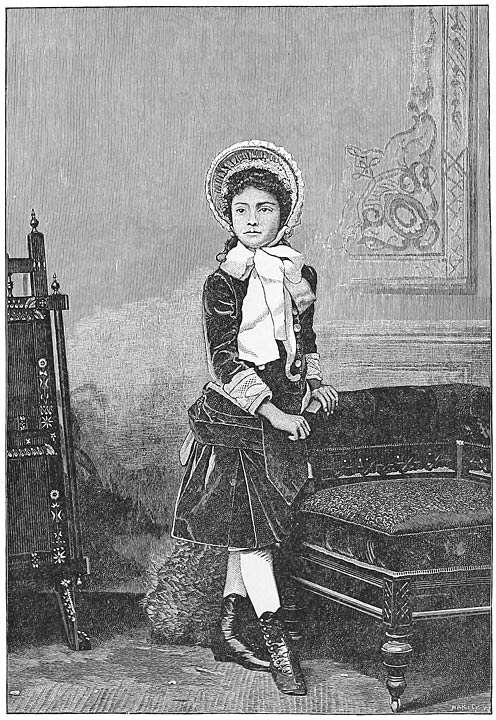
Princess Kauilani.
Kamehameha III. died in 1854 and was succeeded by Kamehameha IV. The latter reigned until 1863, when he died and was succeeded by Prince Lot, with the title of Kamehameha V. In 1864 Lot abrogated the constitution of 1840 and granted a new one. He reigned until 1872, and died without naming a successor, and the Legislative Assembly elected Lunalilo to the throne. He was of the Kamehameha family, and with his death, in 1873, the Kamehameha dynasty came to an end. He, too, failed to designate a successor, and as but two of the accepted descendants of the first Kamehameha remained—one a sister of Kamehameha V. and the other a female cousin of that sovereign—David Kalakaua was elected to the throne by the Legislative Assembly in 1874, receiving all but five votes of that body, which were cast for the queen-dowager Emma, widow of Kamehameha IV.
Provision having been made for the event by a previous Legislative Assembly, King Kalakaua, with his queen, Kapiolani, was formally crowned on the 12th of February, 1883, in the presence of the representatives of many of the nations of the Old World and the New. Since the coronation the last of the Kamehamehas has passed away, including the queen-dowager Emma, and King Kalakaua remains the most direct representative in the kingdom of the ancient sovereigns of Hawaii. He draws his strain from Liloa through the great I family of Hawaii, who joined their fortunes with the first Kamehameha in the conquest of the group. His queen, Kapiolani, is a granddaughter of the last independent sovereign of Kauai, and is thus allied in blood with the early rulers of the group. She is childless, and the Princess Liliuokalani, the elder of the two sisters of the king, has been named as his successor. She is the wife of His Excellency [31]John O. Dominis, an American by birth and present governor of the islands of Oahu and Maui. The only direct heir in the families of the king and his two sisters is the Princess Kaiulani, daughter of the Princess Likelike,1 wife of Mr. Cleghorn, a merchant of Honolulu.
Following is a list of the sovereigns of Hawaii, with the dates and durations of their several governments, from the eleventh to the nineteenth century. It embraces only the rulers of the island of Hawaii, who eventually became the masters of the group. Until the reign of Kalaniopuu, which began in 1754, the dates are merely approximate:
| Pilikaeae, | from A.D. 1095 to 1120 |
| Kukohau, | from,,,,A.D.,, 1120 to 1145 |
| Kaniuhi, | from,,,,A.D.,, 1145 to 1170 |
| Kanipahu, | from,,,,A.D.,, 1170 to 1195 |
| Kalapana (including the usurpation of Kamaiole), | from,,,,A.D.,, 1195 to 1220 |
| Kahaimoelea, | from,,,,A.D.,, 1220 to 1260 |
| Kalaunuiohua, | from,,,,A.D.,, 1260 to 1300 |
| Kuaiwa, | from,,,,A.D.,, 1300 to 1340 |
| Kahoukapu, | from,,,,A.D.,, 1340 to 1380 |
| Kauholanuimahu, | from,,,,A.D.,, 1380 to 1415 |
| Kiha, | from,,,,A.D.,, 1415 to 1455 |
| Liloa, | from,,,,A.D.,, 1455 to 1485 |
| Hakau, | from,,,,A.D.,, 1485 to 1490 |
| Umi, | from,,,,A.D.,, 1490 to 1525 |
| Kealiiokaloa, | from,,,,A.D.,, 1525 to 1535 |
| Keawenui, | from,,,,A.D.,, 1535 to 1565 |
| Kaikilani and Lonoikamakahiki, | from,,,,A.D.,, 1565 to 1595 |
| Keakealanikane, | from,,,,A.D.,, 1595 to 1625 |
| Keakamahana, | from,,,,A.D.,, 1625 to 1655 |
| Keakealaniwahine, | from,,,,A.D.,, 1655 to 1685 |
| Keawe and sister, | from,,,,A.D.,, 1685 to 1720 |
| Alapanui, | from,,,,A.D.,, 1720 to 1754 |
| Kalaniopuu, | from,,,,A.D.,, 1754 to 1782 |
| Kamehameha I, | from,,,,A.D.,, 1782 to 1819 |
| Kamehameha II.—Liholiho, | from,,,,A.D.,, 1819 to 1824 |
| Kaahumanu regency, | from,,,,A.D.,, 1824 to 1833 |
| Kamehameha III.—Kauikeaouli, | from,,,,A.D.,, 1833 to 1854 |
| Kamehameha IV, | from,,,,A.D.,, 1854 to 1863 |
| Kamehameha V.—Lot, | from,,,,A.D.,, 1863 to 1872 |
| Lunalilo, | from,,,,A.D.,, 1872 to 1873 |
| Kalakaua, | from,,,,A.D.,, 1874 to —— |
[32]
Having thus briefly sketched the outlines of the prominent political events of the islands, the ancient religion of the Hawaiians will next be referred to; and as the tabu was no less a religious than a secular prerogative, it may properly be considered in connection with the priesthood. A knowledge of the power, scope and sanctity of the tabu is essential to a proper understanding of the relations existing in the past between the people and their political and religious rulers, and this great governing force will now claim our attention.
THE TABU.
Strictly speaking, the ancient tabu, or kapu, was a prerogative adhering exclusively to political and ecclesiastical rank. It was a command either to do or not to do, and the meaning of it was, “Obey or die.” It was common to the Polynesian tribes, and was a protection to the lives, property and dignity of the priesthood and nobility.
The religious tabus were well understood by the people, as were also the personal or perpetual tabus of the ruling families; but the incidental tabus were oppressive, irksome and dangerous to the masses, as they were liable to be thoughtlessly violated, and death was the usual penalty.
Everything pertaining to the priesthood and temples was sacred, or tabu, and pigs designed for sacrifice, and running at large with the temple mark upon them, could not be molested. It was a violation of perpetual tabu to cross the shadow of the king, to stand in his presence without permission, or to approach him except upon the knees. This did not apply to the higher grades of chiefs, who themselves possessed tabu rights.
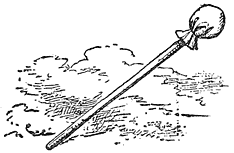
The Puloulou, or Tabu Mark.
Favorite paths, springs, streams and bathing-places were at intervals tabued to the exclusive use of the kings and temples, and squid, turtle, and two or three species of birds could be eaten only by the priests and tabu nobility.
Yellow was the tabu color of royalty, and red of the priesthood, and mantles of the feathers of the oo and mamo could be worn only by kings and princes. Feather capes of mingled red and yellow distinguished the lesser nobility. [33]
Women were tabued from eating plantains, bananas, and cocoanuts; also the flesh of swine and certain fish, among them the kumu, moano, ulua, honu, ea, hahalua and naia; and men and women were allowed under no circumstances to partake of food together. Hence, when Liholiho, in 1819, openly violated this fundamental tabu by eating with his queen, he defied the gods of his fathers and struck at the very foundation of the religious faith of his people.
The general tabus declared by the supreme chief or king were proclaimed by heralds, while the puloulou—a staff surmounted by a crown of white or black kapa—placed at the entrance of temples, royal residences and the mansions of tabu chiefs, or beside springs, groves, paths, or bathing-places, was a standing notification against trespass. General tabus were declared either to propitiate the gods or in celebration of important events. They were either common or strict, and frequently embraced an entire district and continued from one to ten days.
During the continuance of a common tabu the masses were merely required to abstain from their usual occupations and attend the services at the heiaus, or temples; but during a strict tabu every fire and every light was extinguished, no canoe was shoved from the shore, no bathing was permitted, the pigs and fowls were muzzled or placed under calabashes that they might utter no noise, the people conversed in whispers, and the priests and their assistants were alone allowed to be seen without their places of abode. It was a season of deathly silence, and was thought to be especially grateful to the gods.
Some of the royal tabus, centuries back in the past, were frivolous and despotic, such as regulating the wearing of beards and compelling all sails to be lowered on passing certain coast points; but, however capricious or oppressive, the tabu was seldom violated, and its maintenance was deemed a necessary protection to the governing classes.
ANCIENT HAWAIIAN RELIGION.
The ancient religion of the Hawaiians, of which the tabu formed an essential feature, was a theocracy of curious structure. It was a system of idolatrous forms and sacrifices engrafted without consistency upon the Jewish story of the creation, the fall of man, the revolt of Lucifer, the Deluge, and the repopulation of the earth. [34]
The legends of the Hawaiians were preserved with marvellous integrity. Their historians were the priests, who at intervals met in council and recited and compared their genealogical meles, in order that nothing might be either changed or lost. How did the Hawaiian priesthood become possessed of the story of the Hebrew genesis? It was old to them when the Resolution and Discovery dropped their anchors in Kealakeakua Bay; old to them when one or more chance parties of Spanish sailors in the sixteenth century may have looked in upon them for a moment while on their way to the Spice Islands; and it was probably old to them when the Hawaiians found their present home in the sixth century, and when the Polynesians left the coast of Asia four hundred years earlier.
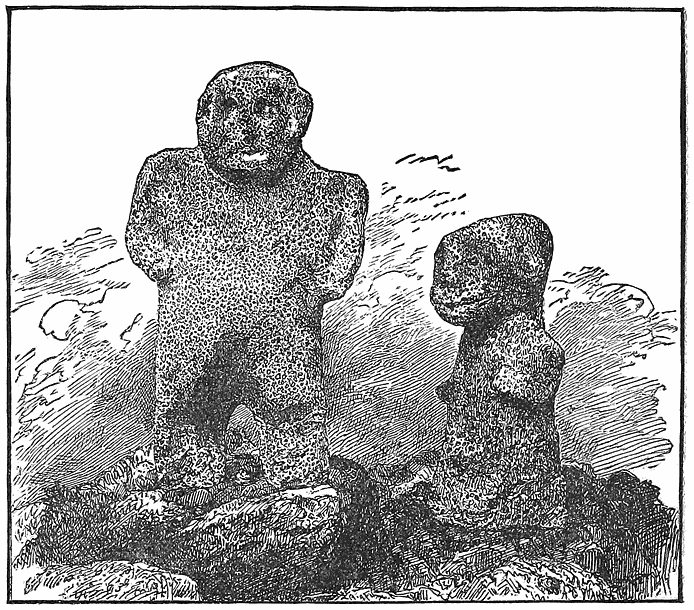
Ancient Gods.
One theory is that the story was acquired through Israelitish contact with the ancestors of the Polynesians while the latter [35]were drifting eastward from the land of their nativity. But the more reasonable assumption seems to be that the Hawaiian theogony, so strangely perpetuated, is an independent and perhaps original version of a series of creation legends common in the remote past to the Cushite, Semite and Aryan tribes, and was handed down quite as accurately as the Jewish version before it became fixed in written characters. In fact, in some respects the Hawaiian seems to be more complete than the Jewish version.
From the beginning, according to Hawaiian story, a trinity of gods existed, who were the sole and all-pervading intelligences of chaos, or night—a condition represented by the Hawaiian word Po. These gods were:
Kane, the originator;
Ku, the architect and builder; and
Lono, the executor and director of the elements.
By the united will of Hikapoloa, or the trinity, light was brought into chaos. They next created the heavens, three in number, as their dwelling-places, and then the earth, sun, moon and stars. From their spittle they next created a host of angels to minister to their wants.
Finally, man was created. His body was formed of red earth mingled with the spittle of Kane, and his head of whitish clay brought by Lono from the four quarters of the earth. The meaning of Adam is red, and it will be remarked that the Hawaiian Adam was made of earth of that color. He was made in the image of Kane, who breathed into his nostrils, and he became alive. Afterwards, from one of his ribs, taken from his side while he slept, a woman was created. The man was called Kumu-honua, and the woman Ke-ola-ku-honua.
The newly-created pair were placed in a beautiful paradise called Paliuli. Three rivers of “the waters of life” ran through it, on the banks of which grew every inviting fruit, including the “tabued bread-fruit tree” and “sacred apple-tree,” with which are connected the fall and expulsion of the man and woman from their earthly paradise. The three rivers had their source in a beautiful lake, fed by “the living waters of Kane.” The waters were filled with fish which fire could not destroy, and on being sprinkled with them the dead were restored to life. Legends relate instances in which these waters were procured, [36]through the favor of the gods, for the restoration to life of distinguished mortals.
As a specimen of the chants perpetuating these traditions and embellishing the plainer prose recitals, the following extract relating to the creation is given:
“Kane of the great Night,
Ku and Lono of the great Night,
Hika-po-loa the king.
The tabued Night that is set apart,
The poisonous Night,
The barren, desolate Night,
The continual darkness of midnight,
The Night, the reviler.
O Kane, O Ku-ka-pao,
And great Lono dwelling in the water,
Brought forth are Heaven and Earth,
Quickened, increased, moving,
Raised up into Continents.
Kane, Lord of Night, Lord the Father,
Ku-ka-pao, in the hot heavens,
Great Lono with the flashing eyes,
Lightning-like has the Lord
Established in truth, O Kane, master-worker;
The Lord creator of mankind:
Start, work, bring forth the chief Kumu-honua,
And Ola-ku-honua, the woman;
Dwelling together are they two.
Dwelling in marriage (is she) with the husband, the brother.”
Among the angels created was Kanaloa, the Hawaiian Lucifer, who incited a rebellion in heaven, with the results, strangely enough, related in immortal song by Milton. When man was created, Kanaloa demanded his adoration. This was refused by Kane, as angels and man were alike the creations of Deity, whereupon Kanaloa ambitiously resolved to create a man of his own who would worship him. Kane allowed him to proceed with his seditious work. He made a man in the exact image of Kumu-honua, but could not give it life. He breathed into its nostrils, but it would not rise; he called to it, but it would not speak. This exasperated him, and he determined to destroy the man made by the gods. He therefore crept into Paliuli in the form of a moo, or lizard, and, through some deception not definitely stated by tradition, Kumu-honua and his mate committed [37]some offence for which they were driven from paradise by the “large, white bird of Kane.”
Kumu-honua had three sons, the second of whom was slain by the first. The name of the Hawaiian Cain is Laka. Ka Pili was the youngest son, and thirteen generations are named between him and the Deluge, whereas the Hebrew version records but ten on the corresponding line of Seth.
The Hawaiian Noah is called Nuu. At the command of the gods he constructed an ark, and entered it with his wife and three sons, and a male and female of every breathing thing. The waters came and covered the earth. When they subsided the gods entered the ark, which was resting on a mountain overlooking a beautiful valley, and commanded Nuu to go forth with all of life that the ark contained. In gratitude for his deliverance Nuu offered a sacrifice to the moon, mistaking it for Kane. Descending on a rainbow, that deity reproved his thoughtlessness, but left the bow as a perpetual token of his forgiveness.
Continuing the genealogical record, ten generations are given between Nuu and Ku Pule, who “removed to a southern country,” taking with him as a wife his slave-woman Ahu. So was it with Abraham. Ku Pule established the practice of circumcision, and was the grandfather of Kini-lau-a-mano, whose twelve children became the founders of twelve tribes, from one of which—the Menehune—the Hawaiians are made to descend.
A story similar to that of Joseph is also given, and mention is made of the subsequent return of the Menehune people to the land set apart for their occupation by Kane. Two brothers led them over deserts and through waters, and after many tribulations they reached their destination.
This would seem to imply that the Menehune people were one of the tribes of Israel; yet it is more probable that they had their origin in some one of the other twelveships into which the early Asiatic tribes were in many instances divided, and that the stories of Joseph and the Exodus became a part of their folk-lore through contact with other races.
The genealogical line from the Hawaiian Adam to the grandson of Ku Pule—that is, until the time of Jacob—has been brought down through three distinct traditional channels. The agreement of the several versions is remarkable, but the one brought to the islands by the high-priest Paao in the eleventh [38]century, and retained by his ecclesiastical successors, is regarded as the most authentic. It was an heirloom of the priesthood, and was never communicated beyond the walls of the temples.
With the settlement of the Menehune people in the land set apart for them by Kane, the Hawaiian legends cease to remind us of the later history of the Hebrews. There the similarity of historic incident abruptly ends, and, with an uncertain stride of twelve or thirteen generations, the chiefly line is brought down to Wakea and his wife Papa, mythical rulers of superhuman attributes, who must have existed before the Polynesians left the Asiatic coast, although in some legends they are connected not only with the first settlement of the Hawaiian archipelago, but with the creation of its islands.
A few of the many legends relating to the creation and first settlement of the islands will be noted. One of them in substance is that Hawaii-loa, a distinguished chief, and fourth in generation from Kini-lau-a-mano, sailed westward, and, guided by the Pleiades, discovered the Hawaiian group. He gave to the largest island his own name, and to the others the names of his children.
Another tradition refers to Papa, the wife of Wakea, as a tabued descendant of Hawaii-loa, and superior in caste to her husband. Mutual jealousies embittered their lives and led to strange events. Wakea found favor with the beautiful Hina, and the island of Molokai was born of their embrace. In retaliation Papa smiled upon the warrior Lua, and the fruit of their meeting was the fair island of Oahu. Hence the old names of Molokai-Hina and Oahu-a-Lua.
Quite as fanciful a legend relates that an immense bird laid an egg on the waters of the ocean. It was hatched by the warm winds of the tropics, and the Hawaiian group came into being. Shortly after a man and woman, with a pair each of dogs, hogs and fowls, came in a canoe from Kahiki, landed on the eastern coast of Hawaii, and became the progenitors of the Hawaiian people.
Fifty-six generations are mentioned from Wakea to the present ruling family. The legends of the twenty-nine generations covering the period between Wakea and Maweke—which brings the record down to the eleventh century, when the second migratory influx from the southern islands occurred—abound in [39]wars, rebellions and popular movements, in which giants, demi-gods, and even the gods themselves took part; and it was doubtless during that period that the idolatrous forms and practices of the Hawaiian religion, as it existed a century ago, were engrafted upon an older and simpler creed confined to the worship of the godhead.
When the high-priest Paao arrived with Pili he introduced some new gods while recognizing the old, strengthened and enlarged the scope of the tabu, and established an hereditary priesthood independent of, and second only in authority to, the supreme political head. Different grades of priests also came into existence, such as seers, prophets, astrologers and kahunas of various function, including the power of healing and destroying. In fact, the priesthood embraced ten distinct grades or colleges, each possessing and exercising powers peculiar to it, and the mastery of all of them was one of the qualifications of the high-priesthood. The tutelar deity of the entire body was Uli.
The form of the heiau, or temple, was changed by Paao and his successors, and the masses mingled less freely in the ceremonies of sacrifice and other forms of worship. The high-priesthood became more mysterious and exclusive, and assumed prerogatives above the reach of royalty. The old Hawaiian trinity—Kane, Ku and Lono—remained the supreme gods of the pantheon, but Kanaloa, the spirit of evil, was accorded beneficent attributes and exalted among them.
The regions of Po, or death, were presided over by Milu, a wicked king who once ruled on earth, while the spirits of favorite chiefs were conveyed by the divine messenger Kuahairo to the presence of Kaono-hio-kala, whose beatific abode was somewhere in the heavens. Another belief was that the ruler of Po was Manua, and that Milu did not follow Akea, the first king of Hawaii, to that place, but dwelt in a region far westward and beneath the sea. Although significant of darkness, Po was not without light. Like Tartarus, it could be visited by favored mortals, and the dead were sometimes brought back from it to earth.
Pele, the dreadful goddess of the volcanoes, with her malignant relatives, was added to the Hawaiian deities during the second influx from the south, and temples were erected to her worship all over the volcanic districts of Hawaii. At that period [40]were also introduced Laamaomao, the god of the winds, the poison goddesses Kalaipahoa and Kapo, and many other deities.
But the worship of the Hawaiians was not confined to Kane, Ku, Lono and Pele. Heiaus were erected to the war-gods of the kings, and great sacrifices were frequently made to them, generally of human beings, preceding, during, and following campaigns and battles. Humbler temples were also maintained to fish, shark, lizard and other gods, where sacrifices of fish and fruits were offered.
To the superstitious masses the land abounded in gnomes and fairies, and the waters in nymphs and monsters, whose caprices are themes of a bountiful store of folk-lore. With almost every stream, gorge and headland is connected some supernatural story, and the bards and musicians of old earned an easy support by keeping alive these legends of the people. To some supernatural powers were given, and malignant and beneficent spirits assumed human forms and flitted among the palms in the guise of birds.

Ku-Kaili-Moku, the War-God of Kamehameha I.
The people made their own household gods, and destroyed them when they failed to contribute to their success. For example, at Ninole, on the southeast coast of Hawaii, is a small beach called Kaloa, the stones of which, it was thought, propagated by contact with each other. From the large stones the people made gods to preside over their games. When a stone was selected for a god it was taken to the heiau, where certain ceremonies were performed over it. It was then dressed and taken to witness some game or pastime. If the owner was successful it was accepted as a god; if unsuccessful more than once or twice, it was thrown away or wrought into an axe or adze. Sometimes a stone of each sex was selected, wrapped in kapa, and laid away. In time a small pebble was found with them. It increased in size, and was finally taken to the heiau and formally made into a god. Such is the story that is still told.
The people believed that the spirits of the departed continued to hover around their earthly homes, and the shades of their ancestors [41]were appealed to in prayer. The owl and a bird called the alae were regarded as gods, and scores of other deities, controlling the elements or presiding over the several industries and amusements of the masses, were recognized and placated with sacrifices when in unfavorable moods. They had a god of the winds, of the husbandman, the warrior, the canoe-maker, the hula dancer, the distiller, the orator, the doctor and the sorcerer, and many gods of the sailor and the fisherman.
The services of the high-priest did not extend to these popular deities on any of the islands of the group. The heiaus over which he presided were dedicated either to the higher gods of the pantheon or to the war-god of the king or supreme chief. He was next to the king in authority, and always of distinguished blood. Surrounded by seers, prophets and assistants, and claiming to hold direct intercourse with the gods, he was consulted on all matters of state consequence, and the auguries of the temple were always accepted with respect and confidence. The high-priest sometimes had charge of the war-god of the king, and in such cases went with it to the field of battle.
Hua, one of the ancient kings of Maui, defied the priesthood and slew his high-priest. As a warning to ruling chiefs, the story of the consequences of Hua’s madness has come down with great conciseness through the chroniclers of the priesthood. Hua’s kingdom became a desolation. Wherever he traveled all vegetation perished, and he finally died of famine on Hawaii, and his bones were left to whiten in the sun.
There were several classes of priests, or kahunas, beside those who were connected with the temples. They were seers, doctors and dealers in enchantment, and subsisted by preying upon the people through their superstitions. All physical illness was attributed either to the anger of the gods, witchcraft, or the prayers of a malignant kahuna. The afflicted person usually sent for a kahuna, whose first business was to discover the cause of the malady through incantation. This ascertained, an effort was made to counteract the spells or prayers which were wearing away the life of the patient, and sometimes with so great success that the affliction was transferred to the party whose malice had invoked it.
The belief that one person might be prayed to death by another was universal with the ancient Hawaiians, and not a few [42]of the race would turn pale to-day if told that one of priestly strain was earnestly praying for his death. In praying a person to death it was essential that the kahuna should possess something closely connected with the person of the victim—a lock of his hair, a tooth, a nail-paring, or a small quantity of his spittle, for example; hence the office of spittoon-bearer to the ancient kings was entrusted only to chiefs of some rank, who might be expected to guard with care the royal expectoration.
The belief was general that the spirits of the dead might be seen and conversed with by the kilos, or sorcerers, and the spirits of the living, it was claimed, were sometimes invoked from their slumbering tabernacles by priests of exceptional sanctity. The spirit of the dead was called unihipili, while the disembodied and visible spirit of a living person was known as kahoaka.
Of all the deities Pele was held in greatest dread on the island of Hawaii, where volcanic irruptions were frequent. With her five brothers and eight sisters—all representing different elemental forces—she dwelt in state in the fiery abysses of the volcanoes, moving from one to another at her pleasure, and visiting with inundations of lava such districts as neglected to cast into the craters proper offerings of meats and fruits, or angered her in other respects. One of her forms was that of a beautiful woman, in which she sometimes sought human society, and numerous legends of her affairs of love have been preserved. She was regarded as the special friend of Kamehameha I., and the suffocation of a portion of the army of Keoua, near the crater of Kilauea, in 1791, was credited directly to her.
The last public recognition of the powers of Pele occurred as late as 1882 on the island of Hawaii. The village of Hilo was threatened. A broad stream of lava from Mauna Loa, after a devastating journey of twenty-five miles or more, reached a point in its downward course within a mile or two of the bay of Hilo. Its movement was slow, like that of all lava-streams some distance from their source, but its steadily approaching line of fire rendered it almost certain that the village, and perhaps the harbor, of Hilo would be destroyed within a very few days. Trenches were digged, walls were raised, and prayers were offered, but all to no purpose. Downward moved the awful avalanche of fire.
Ruth, a surviving sister of the fourth and fifth Kamehamehas, [43]was then living in Honolulu. She was a proud, stern old chiefess, who thought too little of the whites to attempt to acquire their language. The danger threatening Hilo was reported to her. “I will save the fish-ponds of Hilo,” said the old chiefess. “Pele will not refuse to listen to the prayer of a Kamehameha.” She chartered a steamer, left Honolulu for Hilo with a large number of attendants, and the next day stood facing the still moving flow of lava. Ascending an elevation immediately back of the village, she caused to be erected there a rude altar, before which she made her supplications to Pele, with offerings fed to the front of the advancing lava. This done, she descended the hill with confidence and returned to Honolulu.
The stream of fire ceased to move, and to-day its glistening front stands like a wall around Hilo. “A remarkable coincidence,” explained the whites. “The work of Pele,” whispered the natives, although the last of the temples of that goddess had been destroyed sixty years before. Without discussing the cause—a natural one beyond a doubt—it may be remarked that the result has been something of a renewal with the natives of faith in the discarded gods of their fathers.
All of the minor gods of the Hawaiians seem to have been independent and self-controlling. It is not claimed that they derived their powers from, were directed by, or were responsible to the supreme godhead. Hence the mythology of the Polynesians, strong though it be in individual powers and personations of the forces and achievements of nature, presents itself to us in a fragmentary form, like an incongruous patchwork of two or more half-developed or half-forgotten religious systems.
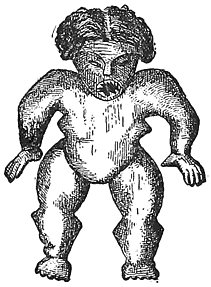
Kalaipahoa, Poison War-Goddess of Molokai.
One of the most noted of the independent deities of the group was Kalaipahoa, the poison-goddess of Molokai. Some centuries back she came to the islands, with two or three of her sisters, from an unknown land, and left her mark in many localities. She entered a grove of trees on the island of Molokai, and left in them a poison so intense that birds fell dead in flying over their branches. The king of the island [44]was advised by his high-priest to have a god hewn from one of the poisoned trees. Hundreds of his subjects perished in the undertaking, but the image was finally finished and presented to the king, wrapped in many folds of kapa. It came down the generations an object of fear, and was finally seized by the first Kamehameha, and at his death divided among his principal chiefs.
Kuula was the principal god of the fishermen on all the islands of the group. Rude temples were erected to him on the shores of favorite fishing-grounds, and the first fish of every catch was his due. His wife was Hina, and she was appealed to when her husband withheld his favors. Laeapua and Kaneapua were gods worshipped by the fishermen of Lanai, and other fish-gods were elsewhere recognized.
There were a number of shark and lizard gods. They were powerful and malignant, and greatly feared by the classes who frequented the sea. Heiaus were erected to them on promontories overlooking the ocean, and the offerings to them of fish and fruits were always liberal. They assumed the forms of gigantic sharks and lizards, and not unfrequently lashed the waters into fury and destroyed canoes. Moaalii was the great shark-god of Molokai and Oahu. Apukohai and Uhumakaikai were the evil gods infesting the waters of Kauai. Lonoakihi was the eel-god of all the islands, and Ukanipo was the shark-god of Hawaii.
Among the celebrated war-gods of the kings of the group was that of Kamehameha I. It was called Kaili, or Ku-kaili-moku, and accompanied the great chief in all of his important battles. It had been the war-god of the Hawaiian kings for many generations, and was given in charge of Kamehameha by his royal uncle, Kalauiopuu. It was a small wooden image, roughly carved, and adorned with a head-dress of yellow feathers. It is said that at times, in the heat of battle, it uttered cries which were heard above the clash of arms. It is not known what became of the image after the death of Kamehameha.
The public heiaus, or temples, of the Hawaiians were usually walled enclosures of from one to five acres, and generally irregular in form. The walls were frequently ten feet in thickness and twenty feet in height, and the material used, was unhewn [45]stone, without mortar or cement. They narrowed slightly from the base upward, and were sometimes capped with hewn slabs of coral or other rock not too firm in texture to be worked with tools of stone.
Within this enclosure was an inner stone or wooden temple of small dimensions, called the luakina, or house of sacrifice, and in front of the entrance to it stood the lele, or altar, consisting of a raised platform of stone. The inner temple was sacred to the priests. Within it stood the anu, a small wicker enclosure, from which issued the oracles of the kaulas, or prophets, and around the walls were ranged charms and gods of especial sanctity. Beside the entrance to this sacred apartment were images of the principal gods, and the outer and inner walls were surmounted by lines of stone and wooden idols.
The enclosure contained other buildings for the accommodation of the high-priest and his assistants; also a house for the governing chief or king, some distance removed from the domiciles of the priest. It was used temporarily by him when on a visit of consultation to the temple, or as a place of refuge in a time of danger. On each side of the entrance to the outer enclosure was a tabu staff, or elevated cross, and near it was a small walled structure in which were slain the victims for the altar.
When an augury was required by the king he frequently visited the heiau in person and propounded his questions to the kaulas. If the answers from the anu were vague and unsatisfactory, other methods of divination were resorted to, such as the opening of pigs and fowls, the shapes of the clouds, the flights of birds, etc. After prayers by the priest the animals were killed, and auguries were gathered from the manner in which they expired, the appearance of the intestines—which were supposed to be the seat of thought—and other signs. Sometimes the spleens of swine were removed, if auguries of war were required, and held above the heads of the priests while prayers were offered.
Before engaging in war or any other important enterprise attended by doubt or danger, human and other sacrifices were made, of which there were fifteen different kinds, and the first prisoners taken in battle were reserved for the altar. The priests named the number of men required for sacrifice, and the king [46]provided them, sometimes from prisoners and malefactors, and sometimes from promiscuous drafts along the highways. The victims were slain with clubs without the temple walls, and their bodies, with other offerings, were laid upon the altar to decay. When the king or other high chief made a special offering of an enemy, the left eye of the victim, after the body had been brought to the altar, was removed and handed to him by the officiating priest. After making a semblance of eating it the chief tossed it upon the altar.
During the construction of heiaus human sacrifices were usually offered as the work progressed, and when completed they were dedicated with great pomp and solemnity, and the altars were sometimes heaped with human bodies. In dedicating ordinary temples the kaiopokeo prayer was employed; but in consecrating heiaus of the first class the kuawili invocation was recited, a prayer continuing from sunrise to sunset. Oil and holy water were sprinkled upon the altars and sacred vessels, and the services were under the direction of the high-priest, and generally in the presence of the governing chief.
The ordinary services in the temples consisted of offerings of fruits and meats, and of chants, prayers and responses, in which the people sometimes joined. Women did not participate in the ceremonies of the temples, but the exclusion found ample compensation in their exemption from sacrifice when human bodies were required.
Temples of refuge, called puhonuas, were maintained on Hawaii, and possibly on Lanai and Oahu in the remote past; but concerning the latter there is some doubt. One of the puhonuas on Hawaii was at Honaunau, near the sacred burial-place of Hale-o-Keawe, and the other at Waipio, connected with the great heiau of Paa-kalani. Their gates were always open, and priests guarded their entrances. Any one who entered their enclosures for protection, whether chief or slave, whether escaping criminal or warrior in retreat, was safe from molestation, even though the king pursued. These places of refuge, with the right of circumcision, which existed until after the death of the first Kamehameha, suggest a Polynesian contact with the descendants of Abraham far back in the past, if not a kinship with one of the scattered tribes of Israel.
In further evidence of the wanderings of the early Polynesians [47]in western and southern Asia, and of their intercourse with the continental races, it may be mentioned that a disposition toward phallic worship, attested by tradition and existing symbols, followed them far out into the Pacific; and that connected with their story of the creation, so closely resembling the Hebrew version, is the Buddhist claim of previous creations which either ran their course or were destroyed by an offended godhead. Nor is Hawaiian tradition content with the mere advancement of the theory of successive creations. It makes specific reference to a creation next preceding that of their Ku-mu-honua, or Adam, and gives the names of the man and woman created and destroyed. They were Wela-ahi-lani and Owe.
It has been mentioned that the birds pueo and alae were sacred and sometimes worshipped. Among the sacred fish were the aku and opelu. How they became so is told in a legend relating to the high-priest Paao, who migrated to the islands in the eleventh century and induced Pili to follow him. Before visiting Hawaii, Paao lived near his brother, probably on the island of Samoa. Both were priests and well skilled in sorcery and divination. The name of the brother was Lonopele. Both were affluent and greatly respected. Lonopele’s lands were near the sea and produced the choicest varieties of fruits. One season, when the fruits were ripening, Lonopele discovered that some one was surreptitiously gathering them in the night-time, and accused one of the sons of Paao of stealing them. Indignant at the charge, and discerning no better way of disproving it, Paao killed and opened his son, and showed his brother that there was no fruit in the stomach of the boy.
Grieved at the death of his son, and holding his brother accountable for it, Paao concluded to emigrate to some other land, and built strong canoes for that purpose. About the time they were completed a son of Lonopele chanced to be in the neighborhood, and Paao, remembering the death of his own son, ordered the boy to be killed. He was missed, and search was made for him, and his body was finally found near Paao’s canoes. Lonopele charged his brother with the murder. Paao did not deny it, and Lonopele ordered him to leave the island. To avoid further trouble Paao set sail at once with a party consisting of thirty-eight persons. One tradition says Pili was of the [48]party; but he must have left Samoa some years later, as Paao sent or went for him after reaching Hawaii.
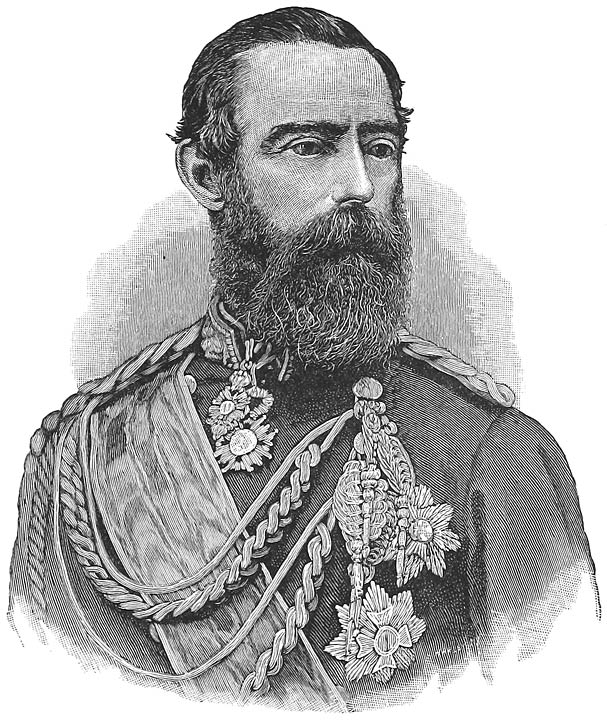
General Dominis, Consort of the Heir-Apparent.
As the canoes were moving from the shore several prophets, standing on the cliffs above, expressed a desire to join the party. “Very well,” was the answer of Paao; “if you are prophets, as you say, leap from the cliffs and I will take you aboard.” Several leaped into the sea and were dashed against the rocks and drowned. Finally Makuakaumana, a prophet of genuine inspiration, who was to have accompanied the expedition, reached the shore and discovered the canoes of Paao far out on the ocean. Raising his voice, he hailed Paao and asked that a canoe might be sent back for him. “Not so,” returned the priest in a loud voice, which the favoring winds bore to the belated prophet. “To return would be an omen of evil. There is room for you, but if you would go with us you must fly to our canoes.” And, flying, the prophet reached the canoes in safety.
Observing the canoes of Paao as they were disappearing in the distance, Lonopele sent a violent storm to destroy them; but the strong fish Aku assisted in propelling the canoes against the storm, and the mighty fish Opelu swam around them and broke the waves with his body. The malignant brother then sent the great bird Kihahakaiwainapali to vomit over the canoes and sink them; but they were hastily covered with mats, and thus escaped destruction. After a long voyage Paao landed in Puna, on the coast of Hawaii. Thenceforth the aku and opelu were held sacred by Paao and his descendants.
Following is a list of the supreme and principal elemental, industrial and tutelar deities of the Hawaiian group:
- The Godhead.
- Kane, the organizer.
- Ku, the architect and builder.
- Lono, the executor.
- Kanaloa, the Lucifer, or fallen angel.
- Rulers in the realms of Po, or death.
- Akea, the first Hawaiian king, who, after life, founded the island-kingdom of Kapapahaunaumoku, in the realms of Po, or death.
- Milu, the successor of Akea, or who, according to another belief, accompanied Akea to Po, and became the perpetual ruler of a kingdom on its western confines.
- Manua, referred to in some legends as the supreme sovereign of Po. With him abide the spirits of distinguished chiefs and priests, who wander among beautiful streams and groves of kou trees, and subsist upon lizards and butterflies.
- Minor Celestial Deities.
- Kaonohiokala (the eyeball of the sun), a celestial god, with an abode somewhere in the heavens, and to whose presence the departed spirits of chiefs were conducted.
- Kuahairo, the messenger who conducted the souls of distinguished chiefs to Kaonohiokala.
- Olopue, a god of Maui, who bore the spirits of noted chiefs to the celestial paradise. Kamehameha sought to secure possession of a very sacred image of this god, inherited by Kahekili, moi of Maui.
- The Volcanic Deities.
- Pele, the ruling goddess of the volcanoes, with her sisters,
- Hiiaka-wawahi-lani, the heaven-rending cloud-holder;
- Makoie-nawahi-waa, the fire-eyed canoe-breaker;
- Hiiaka-noho-lani, the heaven-dwelling cloud-holder;
- Hiiaka-kaalawa-maka, the quick-glancing cloud-holder;
- Hiiaka-hoi-ke-poli-a-pele, the cloud-holder kissing the bosom of Pele;
- Hiiaka-ka-pu-enaena, the red-hot mountain lifting clouds;
- Hiiaka-kaleiia, the wreath encircled cloud-holder;
- Hiiaka-opio, the young cloud-holder; and their brothers,
- Kamo-hoalii, or King Moho, the king of vapor or steam;
- Kapohoikahiola, god of explosions;
- Keuakepo, god of the night-rain, or rain of fire;
- Kane-kahili, the husband of thunder, or thundering god;
- Keoahi-kamakaua, the fire-thrusting child of war.
- [The last two were hunchbacks.]
- Akuapaao, the war-god of Paao, taken from the temple of Manini by Umi.
- Ku-kaili-moku, the war-god of Kamehameha I., bequeathed to him by Kalaniopuu.
- Deities of the Elements.
- Laamaomao, god of the winds, the Hawaiian Æolus, whose home was on Molokai.
- Hinakuluiau, a goddess of the rain.
- Hinakealii and
- Hookuipaele, sisters of Hinakuluiau.
- Mooaleo, a powerful gnome of Lanai, conquered by Kaululaau, a prince of Maui.
- Kuula, a god of the fishermen.
- Hina, wife of Kuula.
- Laeapua and
- Kaneapua, gods of the fishermen of Lanai.
- Hinahele and her daughter
- Aiaiakuula, goddesses of the fishermen of Hawaii.
- Ukanipo, the great shark-god of Hawaii.
- Moaalii, the principal shark-god of Molokai and Oahu.
- Lonoakiki, the great eel-god of all the group.
- Apukohai and
- Uhumakaikai, evil shark or fish-gods of Kauai.
- Gods of the Arts and Industries.
- Akua-ula, the god of inspiration.
- Haulili, a god of speech, special to Kauai.
- Koleamoku, the deified chief who first learned the use of herbs and the art of healing from the gods. He was a patron of the kahunas.
- Olonopuha and
- Makanuiailone, deified disciples of Koleamoku.
- Kaanahua, the second son of the high-priest Luahoomoe, and
- Kukaoo, gods of the husbandman.
- Lakakane, god of the hula and similar sports.
- Mokualii, god of the canoe-makers.
- Hai, god of kapa making.
- Ulaulakeahi, god of distillation.
- Kalaipahoa, a goddess who entered and poisoned trees.
- Kapo and
- Pua, sisters of Kalaipahoa, with like functions.
- Kama, a powerful tutelar god of all the islands.
- Laauli, the god who made inviolable laws.
- Kuahana, the god who killed men wantonly.
- Leleioio, the god who inflicted bodily pain.
- Lelehookaahaa, wife of Leleioio.
- Lie, a goddess of the mountains, who braided leis.
- Maikahulipu, the god who assisted in righting upset canoes.
- Pohakaa, a god living in precipitous places, and who rolled down stones, to the fright and injury of passers.
- Keoloewa, a god worshipped in the heiaus of Maui.
- Kiha, a goddess of Maui, held in great reverence.
- Uli, the god of the sorcerers.
- Pekuku, a powerful god of Hawaii.
- Lonoikeaualii, a god worshipped in the heiaus of Oahu.
- Kauakahi, a god of Maui and Molokai.
- Hiaka, a mountain god of Kauai.
- Kapo and
- Kapua, and several others, messengers of the gods.
- Ouli, the god appealed to by the kahunas in praying people to death.
- Maliu, any deified deceased chief.
- Akua noho, gods possessing the spirits of departed mortals, of which there were many.
- Kiha-wahine and
- Kalo, noted deities of the class of akua-noho.
- Mahulu, a name common to three gods in the temples of Lono.
- Manu, the names of two gods at the outer gates of heiaus dedicated to Lono.
- Puea, the god worshipped in the darkness.
- Kaluanuunohonionio, one of the principal gods of the luakina, or sacrificial house of the temple.
- Kanenuiakea, a general name for a class of thirteen gods connected with the larger heiaus.
[51]
ANCIENT HAWAIIAN GOVERNMENT.
Previous to the eleventh century the several habitable islands of the Hawaiian group were governed by one or more independent chiefs, as already stated. After the migratory influx of that period, however, and the settlement on the islands of a number of warlike southern chiefs and their followers, the independent chiefs began to unite for mutual protection. This involved the necessity of a supreme head, which was usually found in the chief conceded to be the most powerful; and thus alii-nuis, mois and kings sprang into existence. So far as tradition extends, however, certain lines, such as the Maweke, Pili and Paumakua families, were always considered to be of supreme blood. They came to the islands as chiefs of distinguished lineage, and so remained.
Gradually the powers of the mois and ruling chiefs were enlarged, until at length they claimed almost everything. Then the chiefs held their possessions in fief to the moi, and forfeited them by rebellion. In time the king became absolute master of the most of the soil over which he ruled, and assumed tabu rights which rendered his person sacred and his prerogatives more secure. All he acquired by conquest was his, and by partitioning the lands among his titled friends he secured the support necessary to his maintenance in power. Certain lands were inalienable both in chiefly families and the priesthood; they were made so by early sovereign decrees, which continued to be respected; but with each succeeding king important land changes usually occurred.
Although the king maintained fish-ponds and cultivated lands of his own, he was largely supported by his subject chiefs. They were expected to contribute to him whatever was demanded either of food, raiment, houses, canoes, weapons or labor, and in turn they took such portions of the products of their tenants as their necessities required. The ili was the smallest political division; next above it was the ahapuaa, which paid a nominal or special tax of one hog monthly to the king; next the okana, embracing several ahapuaas; and finally the moku, or district, or island.
The laboring classes possessed no realty of their own, nor could they anywhere escape the claim or jurisdiction of a chief [52]or landlord. They owed military and other personal service to their respective chiefs, and the chiefs owed theirs to the king. If required, all were expected to respond to a call to the field, fully armed and prepared for battle.
Caste rules of dress, ornamentation and social forms were rigidly enforced. The entire people were divided into four general classes: first, the alii, or chiefly families, of various grades and prerogatives; second, the kahunas, embracing priests, prophets, doctors, diviners and astrologers; third, the kanaka-wale, or free private citizens; and, fourth, the kauwa-maoli, or slaves, either captured in war or born of slave parents.
The laws were few and simple, and the most of them referred to the rights and prerogatives of the king, priesthood and nobility. Property disputes of the masses were settled by their chiefs, and other grievances were in most instances left to private redress, which frequently and very naturally resulted in prolonged and fatal family feuds, in the end requiring chiefly and sometimes royal intervention.
This, in brief and very general terms, was the prevailing character of the government and land tenure throughout the several islands of the group until after the death of Kamehameha I. in 1819, and the relinquishment by the crown of its ancient and sovereign rights in the soil.
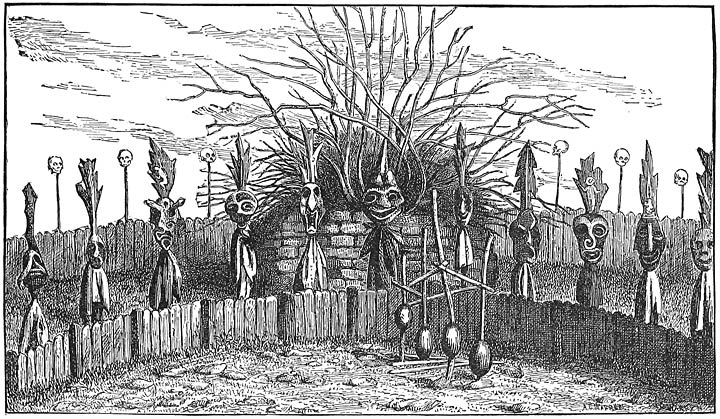
Meeting Place of an Ancient Secret Society.
(FROM A PAINTING IN THE ROYAL PALACE.)
The leading chiefs and high-priesthood claimed a lineage distinct from that of the masses, and traced their ancestry back to Kumuhonua, the Polynesian Adam. The iku-pau, a sacred class of the supreme priesthood, assumed to be the direct descendants from the godhead, while the iku-nuu were a collateral branch of the sacred and royal strain, and possessed only temporal powers. It was thus that one of the families of the Hawaiian priesthood, in charge of the verbal genealogical records, exalted itself in sanctity above the political rulers.
Proud of their lineage, to guard against imposture and keep their blood uncorrupted, the chiefs allowed their claims to family distinction to be passed upon by a college of heraldry, established by an early moi of Maui. Reciting their genealogies before the college, composed of aliis of accepted rank, and receiving the recognition of the council, chiefs were then regarded as members of the grade of aha-alii, or chiefs of admitted and irrevocable rank. [53]
The chiefs inherited their titles and tabu privileges quite as frequently through the rank of one parent as of the other. As Hawaiian women of distinction usually had more than one husband, and the chiefs were seldom content with a single wife, the difficulty of determining the rights and ranks of their children was by no means easy; but the averment of the mother was generally accepted as conclusive and sufficient evidence in that regard.
For political purposes marriage alliances were common between the royal and chiefly families of the several islands, and thus in time the superior nobility of the entire group became connected by ties of blood. The political or principal wife of a king or distinguished chief was usually of a rank equal to that of her husband, and their marriage was proclaimed by heralds and celebrated with befitting ceremonies. Other wives were taken by simple agreement, and without ceremony or public announcement. Very much in the same manner the masses entered into their marriage unions. With the latter, however, polygamy was not common. When husband and wife separated, as they frequently did, each was at liberty to select another partner. The political wife of a chief was called wahine-hoao; the others, haia-wahine, or concubine.
In the royal families, to subserve purposes of state, father and daughter, brother and sister, and uncle and niece frequently united as man and wife. The children of such unions were esteemed of the highest rank, and, strange to say, no mental or physical deterioration seemed to result from these incestuous relations, for all through the past the mois and nobles of the group were noted for their gigantic proportions.
There were five or more grades of chiefs connected with the royal lines. First in order, and the most sacred, was the alii-niaupio (the offspring of a prince with his own sister); next, the alii-pio (the offspring of a prince with his own niece); next, the alii-naha (the offspring of a prince or king with his own daughter); next, the alii-wohi (the offspring of either of the foregoing with another chiefly branch); and next, the lo-alii (chiefs of royal blood). Any of these might be either male or female.
To these grades of chiefs distinct personal tabus or prerogatives were attached, such as the tabu-moe, tabu-wela, tabu-hoano and tabu-wohi. These tabus could be given or bequeathed to others [54]by their possessors, but could not be multiplied by transmission. The meles, or ancestral chants of a family, passed in succession to the legal representatives, and became exclusively theirs; but the government, tabus and household gods of the king were subject to his disposal as he willed, either at his death or before it. The child of a tabu chief, born of a mother of lower rank, could not, according to custom, assume the tabu privileges of his father, although in some instances in the past they were made to inure to such offspring, notably in the case of Umi, King of Hawaii.
Before an alii-niaupio, clothed with the supreme function of the tabu-moe, all, with the exception of tabu chiefs, were compelled to prostrate themselves. When he appeared or was approached his rank was announced by an attendant, and all not exempt from the homage were required to drop with their faces to the earth. The exemptions were the alii-pio, the alii-naha, the alii-wohi and the lo-alii. They, and they alone, were permitted to stand in the presence of a niaupio chief. An alii-pio was also a sacred chief, so much so that he conversed with others only in the night-time, and on chiefesses of that rank the sun was not allowed to shine.
The kings lived in affluence in large mansions of wood or stone, in the midst of walled grounds adorned with fruit and shade trees and other attractive forms of vegetation. The grounds also contained many other smaller buildings for the accommodation of guests, retainers, attendants, servants and guards. They were attended by their high-priests, civil and military advisers, and a retinue of favorite chiefs, and spent their time, when not employed in war or affairs of state, in indolent and dignified repose.
The personal attendants of an ancient Hawaiian king were all of noble blood, and each had his specified duty. They were known as kahu-alii, or guardians of the person of the king. They consisted of the iwikuamoo, or rubber of the person; the ipukuha, or spittoon-bearer; the paakahili, or kahili-bearer; the kiaipoo, or sleep-watcher; and the aipuupuu, or steward. Other inferior chiefs, called puuku, with messengers, spies, executioners, prophets, astrologers, poets, historians, musicians and dancers, were among his retainers. Connected with the palace was an apartment used as a heiau, or chapel, which was sometimes in charge of the high-priest. [55]
During festival seasons brilliant feasts, tournaments and hula and musical entertainments were given in the royal grounds, and the court was splendid in displays of flowers, feathers and other gaudy trappings. The king not unfrequently took part in the manly games and exercises of the chiefs, and sometimes complimented the hula dancers and musicians by joining in their performances.
To render the kings and higher nobility still more exclusive, they had a court language which was understood only by themselves, and which was changed in part from time to time as its expressions found interpretation beyond the royal circle. Some portions of this court language have been preserved.
ARTS, HABITS AND CUSTOMS.
All implements of war or industry known to the early Hawaiians were made either of wood, stone, or bone, as the islands are destitute of metals; but with these rude helps they laid up hewn-stone walls, felled trees, made canoes and barges, manufactured cloths and cordage, fashioned weapons, constructed dwellings and temples, roads and fish-ponds, and tilled the soil. They had axes, adzes and hammers of stone, spades of wood, knives of flint and ivory, needles of thorn and bone, and spears and daggers of hardened wood. They wove mats for sails and other purposes, and from the inner bark of the paper mulberry-tree beat out a fine, thin cloth called kapa, which they ornamented with colors and figures.
Their food was the flesh of swine, dogs and fowls; fish, and almost everything living in the sea; taro, sweet potatoes and yams, and fruits, berries and edible sea-weed of various kinds. Poi, the favorite food of all classes, was a slightly fermented paste made of cooked and pounded taro, a large bulbous root, in taste resembling an Indian turnip. They made a stupefying beverage by chewing the awa root, and from the sweet root of the ti plant fermented an intoxicating drink. The soft parts of the sugar-cane were eaten, but, with the exception of the manufacture of a beer called uiuia, no other use seems to have been made of it. Their food, wrapped in ti leaves, was usually cooked in heated and covered pits in the earth. Their household vessels were shells, gourd calabashes of various shapes and sizes, and platters and other containers made of wood. [56]
The dress of the ancient Hawaiian was scant, simple and cool. The principal, and generally the only, garment of the male was the maro, a narrow cloth fastened around the loins. To this was sometimes added, among the masses, a kihei, or cloth thrown loosely over the shoulders. The females wore a pau, or skirt of invariably five thicknesses of kapa, fastened around the waist and extending to the knees. When the weather was cool a short mantle was sometimes added. Ordinarily the heads of both sexes were without coverings, and in rare instances they wore kamaas, or sandals of ti or pandanus leaves.
With the maro, which was common to the males of all ranks, the king on state occasions wore the royal mamo, a mantle reaching to the ankles, and made of the yellow feathers of a little sea-bird called the mamo. When it is mentioned that but a single yellow feather is found under each wing of the mamo, and that tens of thousands, perhaps, entered into the fabrication of a single mantle, some idea of the value of such a garment may be gathered. A few of these royal cloaks are still in existence, one of which was worn by King Kalakaua during the ceremonies of his late coronation. Pure yellow was the royal color. The shorter capes or mantles of the chiefs were of yellow feathers mixed with red. The color of the priests and gods was red.
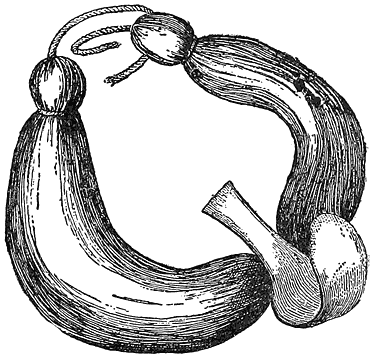
Palaoa, a Talisman worn around the Neck.
The ornaments of the nobility consisted of head-dresses of feathers, palaoas, or charms of bone suspended from the neck, and necklaces and bracelets of shells, teeth and other materials. Many of them were tattooed on the face, thighs and breast, but the practice was not universal. Flowers were in general use as ornaments, and at feasts, festivals and other gatherings garlands of fragrant leaves and blossoms crowned the heads and encircled the necks of all. This is among the beautiful customs still retained by the Hawaiians. [57]
The dwellings of the masses were constructed of upright posts planted in the ground, with cross-beams and rafters, and roofs and sides of woven twigs and branches thatched with leaves. The houses of the nobility were larger, stronger and more pretentious, and were frequently surrounded by broad verandas. It was a custom to locate dwellings so that the main entrance would face the east, the home of Kane. The opposite entrance looked toward Kahiki, the land from which Wakea came.
The homes of well-conditioned Hawaiians consisted of no less than six separate dwellings or apartments: 1st, the heiau, or idol-house; 2d, the mua, or eating-house of the males, which females were not allowed to enter; 3d, the hale-noa, or house of the women, which men could not enter; 4th, the hale-aina, or eating-house of the wife; 5th, the kua, or wife’s working-house; and 6th, the hale-pea, or retiring-house or nursery of the wife. The poorer classes followed these regulations so far as their means would admit, but screens usually took the place of separate dwellings or definite apartments.
When war was declared or invasion threatened, messengers, called lunapais, were despatched by the king to his subject chiefs, who promptly responded in warriors, canoes, or whatever else was demanded. A regular line-of-battle consisted of a centre and right and left wings, and marked military genius was sometimes displayed in the handling of armies. Sea-battles, where hundreds, sometimes thousands, of war-canoes met in hostile shock, were common, and usually resulted in great loss of life. Truces and terms of peace were ordinarily respected, but few prisoners were spared except for sacrifice.
The weapons of the islanders were spears about twenty feet in length, javelins, war-clubs, stone axes, rude halberds, knives, daggers and slings. The slings were made either of cocoa fibre or human hair. The stones thrown were sometimes a pound or more in weight, and were delivered with great force and accuracy. The spears were sometimes thrown, while the javelins were reserved for closer encounter. Shields were unknown. Hostile missiles were either dodged, caught in the hands, or dexterously warded. The chiefs frequently wore feather helmets in battle, but the person was without protection.

Surf Board.
The athletic sports and games of the people were numerous. [58]The muscular pastimes consisted in part of contests in running, jumping, boxing, wrestling, swimming, diving, canoe-racing and surf-riding. Rolling round stone disks and throwing darts along a prepared channel was a favorite sport; but the most exciting was the holua contest, in which two or more might engage. On long, light and narrow sledges the contestants, lying prone, dashed down long and steep declivities, the victory being with the one who first reached the bottom. The goddess Pele enjoyed the game, and frequently engaged in it. But she was a dangerous contestant. On being beaten by Kahavari, a chief of Puna, she drove him from the district with a stream of lava. Sham battles and spear and stone throwing were also popular exercises.
Among the in-door games were konane, kilu, puhenehene, punipiki, and hiua. Konane resembled the English game of draughts. Puhenehene consisted of the adroit hiding by one of the players of a small object under one of several mats in the midst of the party of contestants, and the designation of its place of concealment by the others. Kilu was a game somewhat similar, accompanied by singing. Punipiki was something like the game of “fox and geese,” and hiua was played on a board with four squares. These were the most ancient of Hawaiian household games.
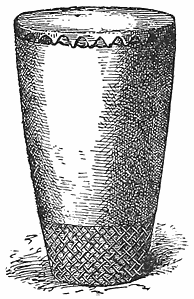
Pahu, or Drum.
The musical instruments of the islanders were few and simple. They consisted of pahus, or drums, of various sizes; the ohe, a bamboo flute; the hokio, a rude clarionet; a nasal flageolet, and a reed instrument played by the aid of the voice. To these were added, on special occasions, castanets and dry gourds containing pebbles, which were used to mark the time of chants and other music. They had many varieties of dances, or hulas, all of which were more or less graceful, and a few of which were coarse and licentious. Bands of hula dancers, male and female, were among [59]the retainers of the mois and prominent chiefs, and their services were required on every festive occasion.
The mourning customs of the people were peculiar. For days they wailed and feasted together over a dead relative or friend, frequently knocking out one or more teeth, shaving portions of their heads and beards, and tearing their flesh and clothes. But their wildest displays of grief were on the death of their kings and governing chiefs. During a royal mourning season, which sometimes continued for weeks, the people indulged in an unrestrained saturnalia of recklessness and license. Every law was openly violated, every conceivable crime committed. The excuse was—and the authorities were compelled to accept it—that grief had temporarily unseated the popular reason, and they were not responsible for their misdemeanors.
The masses buried their dead or deposited the bodies in caves, but the bones of the kings were otherwise disposed of. There were royal burial-places—one at Honaunau, on the island of Hawaii, and another, called Iao, on Maui—and the tombs of many of the ancient mois and ruling chiefs were in one or the other of those sacred spots; but they probably contained but few royal bones. In the fear that the bones of the mois and distinguished chiefs might fall into the hands of their enemies and be used for fish-hooks, arrow-points for shooting mice, and other debasing purposes, they were usually destroyed or hidden. Some were weighted and thrown into the sea, and others, after the flesh had been removed from them and burned, were secreted in mountain caves. The hearts of the kings of the island of Hawaii were frequently thrown into the crater of Kilauea as an offering to Pele. The bones of the first Kamehameha were so well secreted in some cave in Kona that they have not yet been found, and the bones of Kualii, a celebrated Oahuan king of the seventeenth century, were reduced to powder, mingled with poi, and at the funeral feast fed to a hundred unsuspecting chiefs.
GROUP OF NATIVE IMPLEMENTS.
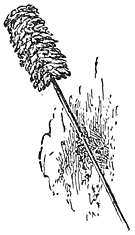
Hand Kahili.
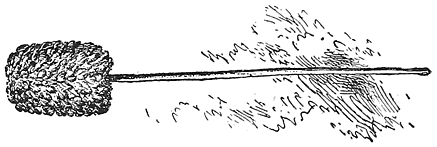
Kahili, or Royal Feather Standard.
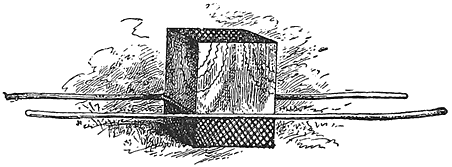
Mauele, or Native Palanquin.

Paddle.
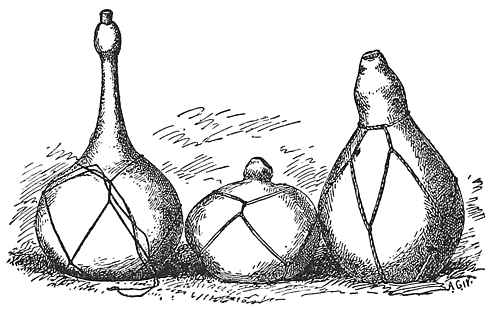
Gourds.
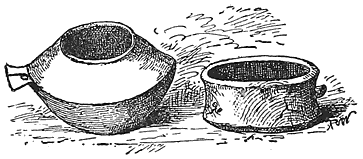
Spittoons.

Kepie, or Sledge used in the Game of Holua.
The ancient Hawaiians divided the year into twelve months of thirty days each. The days of the month were named, not numbered. As this gave but three hundred and sixty days to their year, they added and gave to their god Lono in feasting and festivity the number of days required to complete the sidereal year, which was regulated by the rising of the Pleiades. The new [61]year began with the winter solstice. They also reckoned by lunar months in the regulation of their monthly feasts. The year was divided into two seasons—the rainy and the dry—and the day into three general parts, morning, noon and night. The first, middle and after parts of the night were also designated.
As elsewhere mentioned, they had names for the five principal planets, which they called “the wandering stars,” and for a number of heavenly groups and constellations. It was this knowledge of the heavens that enabled them to navigate the ocean in their frail canoes.
In counting, the Hawaiians reckoned by fours and their multiples. Their highest expressed number was four hundred thousand. More than that was indefinite.
After what has been written it would seem scarcely necessary to mention that the Hawaiians were not cannibals. Their legends refer to two or three instances of cannibalism on the islands, but the man-eaters were natives of some other group and did not long survive.
THE HAWAII OF TO-DAY.
With this somewhat extended reference to the past of the Hawaiian Islands and their people, it is deemed that a brief allusion to their present political, social, industrial and commercial condition will not be out of place. The legends presented leave the simple but warlike islanders standing naked but not ashamed in the light of civilization suddenly flashed upon them from across the seas. In the darkness behind them are legends and spears; in the light before them are history and law. Let us see what the years since have done for them.
The Hawaiian government of to-day is a mild constitutional monarchy, the ruling family claiming descent from the most ancient and respected of the chiefly blood of Hawaii. The departments of the government are legislative, executive and judicial.
The Legislative Assembly, which meets every two years, consists of representatives chosen by the people, nobles named by the sovereign, and crown ministers. They act in a single body, choosing their presiding officer by ballot, and their proceedings are held jointly in the English and Hawaiian languages, and in both are their laws and proceedings published. As the elective franchise is confined to native and naturalized citizens, the most [62]of the representatives chosen by the people are natives, all of whom are more or less educated, and many of whom are graceful and eloquent debaters. White representatives of accepted sympathy with the natives are occasionally elected, and a majority of the nobles and ministers are white men. The English common law is the basis of their statutes, and their civil and criminal codes are not unlike our own. The Legislature fixes tax, excise and customs charges, and provides by appropriation for all public expenditure. The representatives are paid small salaries, and the Legislature is formally convened and prorogued by the king in person.
Although the present sovereign was elected by the Legislature, for the reason heretofore mentioned, the naming of a successor is left to the occupant of the throne. The king is provided at public expense with a palace and royal guard, and appropriations of money amounting to perhaps forty thousand dollars yearly. He has also some additional income from what are known as crown lands. The two sisters of the king and the daughter of one of them receive from the treasury an aggregate of fifteen thousand five hundred dollars yearly. The king entertains liberally, is generous with his friends and attendants, and probably finds his income no more than sufficient to meet his wants from year to year. His advisers are four Ministers of State and a Privy Council. The Ministry is composed of a Minister of Foreign Affairs, who ranks as premier, Minister of Finance, Minister of Interior, and Attorney-General. The Privy Council is composed of thirty or forty leading citizens appointed by the Crown. In certain matters they have original and exclusive powers. They are convened in council from time to time, but receive no compensation. The most of the Privy Councillors are white men, and embrace almost every nationality. The majority of the ministers of state are usually white men of ability, and their salaries are six thousand dollars per annum each.
The judiciary is composed of a Supreme Court of three members, one of whom is chief-justice and chancellor, Circuit Courts holden in different districts, and minor magistrates’ courts in localities where they are required. The Supreme and Circuit judges are all white men, and but few magistrates are natives. The salaries of the superior judges are respectable, and the most of them are men of ability. The laws, as a rule, are intelligently [63]administered and promptly executed, and life and property are amply protected.
Public schools are numerous throughout the islands, and are largely attended by native children. A considerable proportion of the adult natives are able to read and write their own language, and a number of native newspapers and periodicals are sustained. The English press of Honolulu—the only point of publication—is respectable in ability and enterprise.
Leprosy was brought to the islands by the Chinese about forty years ago, and has become a dangerous and loathsome scourge. Lepers are seldom encountered, however, as they are removed, whenever discovered, to the island of Molokai, where they are humanely cared for by the government. It is a cureless but painless affliction, and is doubtless contagious under certain conditions. Nine-tenths or more of the lepers are either natives or Chinese, and the whole number amounts to perhaps twelve hundred. It is not thought that the malady is increasing, and it is hoped that a careful segregation of the afflicted will in time eradicate the disease from the group.
The commerce of the islands is largely in the hands of foreigners, and the sugar plantations are almost exclusively under their control. There are but few native merchants, the large dealers being Americans, Germans, English and French, while the smaller traders are generally Portuguese and Chinese. There are native lawyers, clerks, mechanics, magistrates and police-men; but the most of the race who are compelled to labor for their support find employment as farm and plantation laborers, stevedores, sailors, coachmen, boatmen, fishermen, gardeners, fruit-pedlars, waiters, soldiers and house-servants, in all of which capacities they are generally industrious, cheerful and honest.
The products of the islands for export are sugar, molasses, rice, bananas, fungus, hides and wool, of an aggregate approximate value of eight million dollars annually. The principal product, however, is sugar, amounting to perhaps one hundred thousand tons yearly. Nine-tenths of the exports of the group find a market in the United States, and four-fifths or more of the imports in value are from the great Republic. The receipts and expenditures of the government are a little less than one million five hundred thousand dollars annually, derived principally from customs duties and direct taxation. [64]
The population of the islands is a little more than eighty thousand, of which about forty-five thousand are natives. The Americans, English, Germans, Norwegians and French number perhaps ten thousand, and Chinese, Japanese and Portuguese from the Azores constitute the most of the remainder.
The postal facilities of the islands are ample and reliable. Inter-island steamers, of which there are many, convey the mails throughout the group at regular intervals, and the San Franciscan and Australian steamers afford a punctual and trustworthy service with the rest of the world. The islands have a postal money-order system reaching within and beyond their boundaries, and are connected with the Universal Postal Union.
Over twenty thousand of the inhabitants of the group are centred in Honolulu, the capital of the kingdom, and its beautiful and dreamy suburb of Waikiki. The business portions of the city, with their macadamized and lighted streets, and blocks of brick and stone buildings, have a thrifty and permanent appearance, while the eastern suburbs, approaching the hills with a gentle ascent, abound in charming residences embowered in palms. Small mountain streams run through the city and afford an abundant supply of sweet water, which is further augmented by a number of flowing artesian wells. With a temperature ranging from seventy to ninety degrees, Honolulu, with its substantial churches and public buildings, its air of affluence and dreamy quiet, is a delightful place of residence to those who enjoy the heat and languor of the tropics.
In the midst of these evidences of prosperity and advancement it is but too apparent that the natives are steadily decreasing in numbers and gradually losing their hold upon the fair land of their fathers. Within a century they have dwindled from four hundred thousand healthy and happy children of nature, without care and without want, to a little more than a tenth of that number of landless, hopeless victims to the greed and vices of civilization. They are slowly sinking under the restraints and burdens of their surroundings, and will in time succumb to social and political conditions foreign to their natures and poisonous to their blood. Year by year their footprints will grow more dim along the sands of their reef-sheltered shores, and fainter and fainter will come their simple songs from the shadows of the palms, until finally their voices will be heard no more for ever. [65]And then, if not before—and no human effort can shape it otherwise—the Hawaiian Islands, with the echoes of their songs and the sweets of their green fields, will pass into the political, as they are now firmly within the commercial, system of the great American Republic.
February, 1887. [67]

